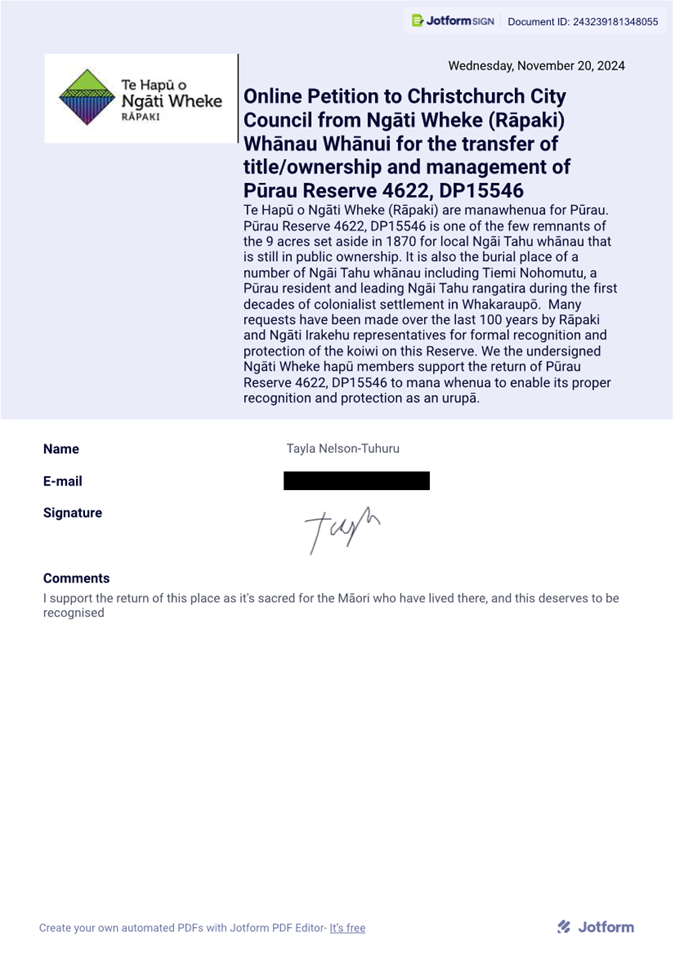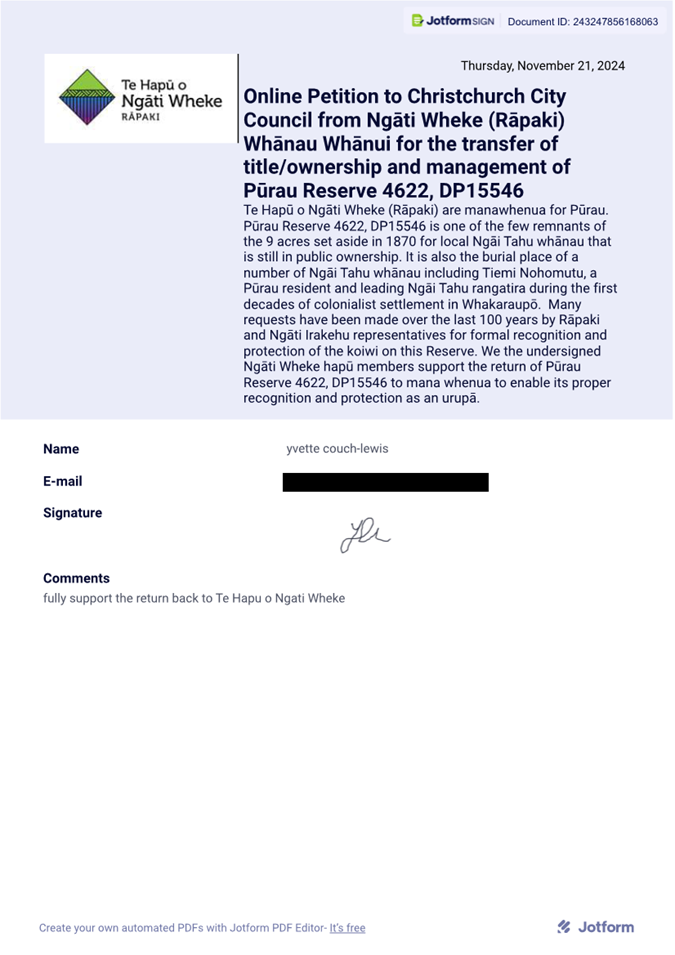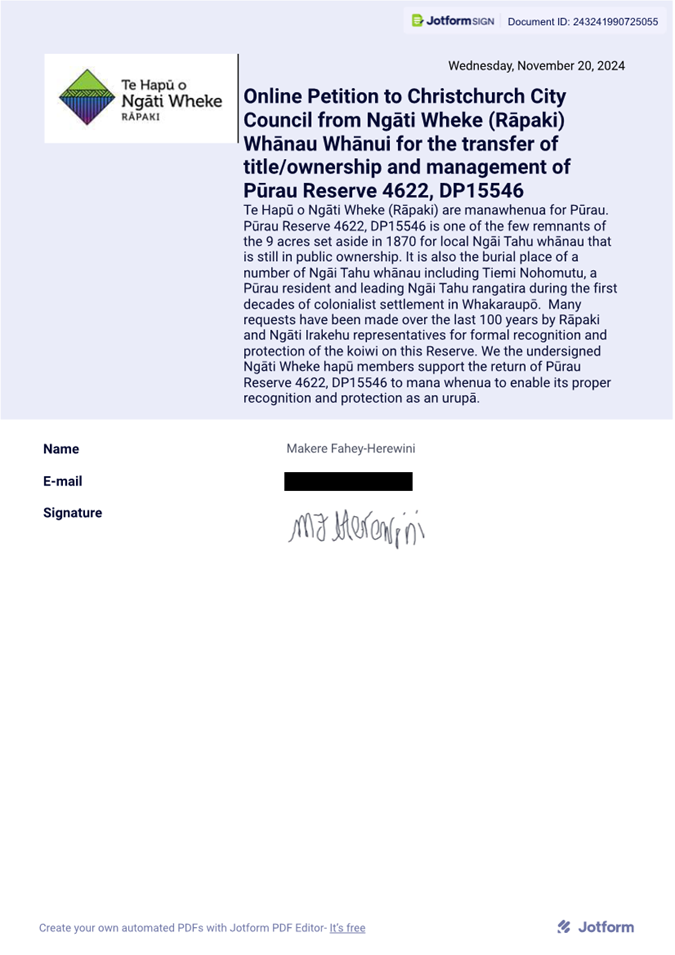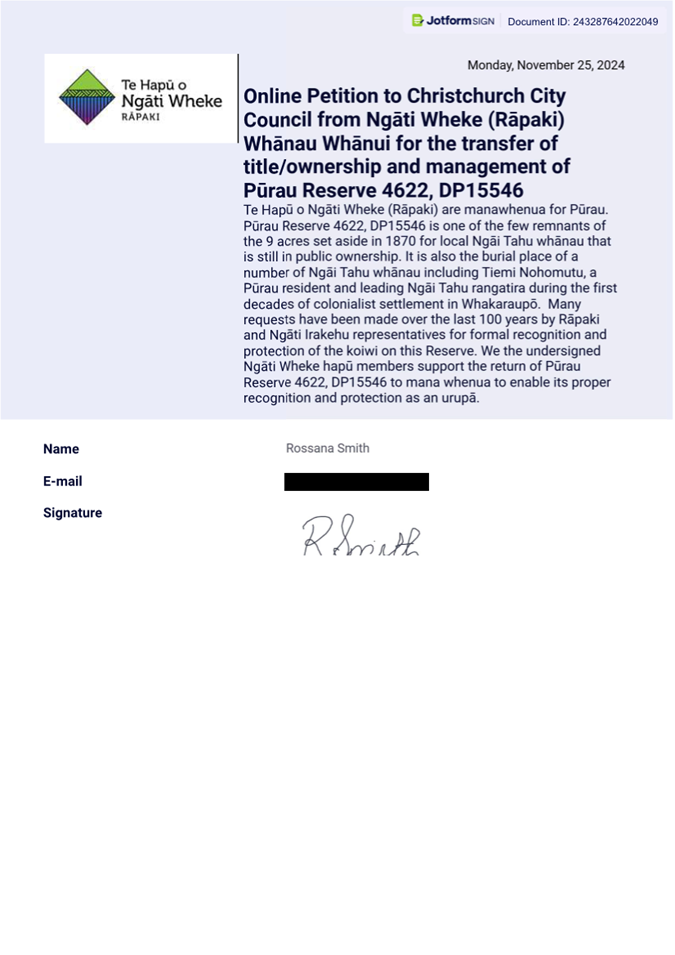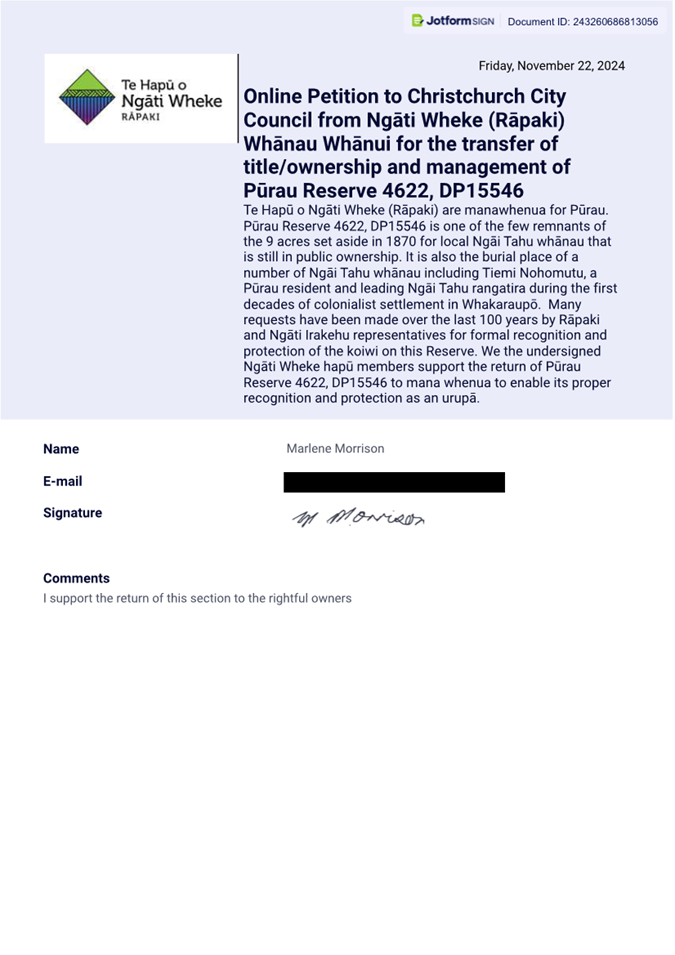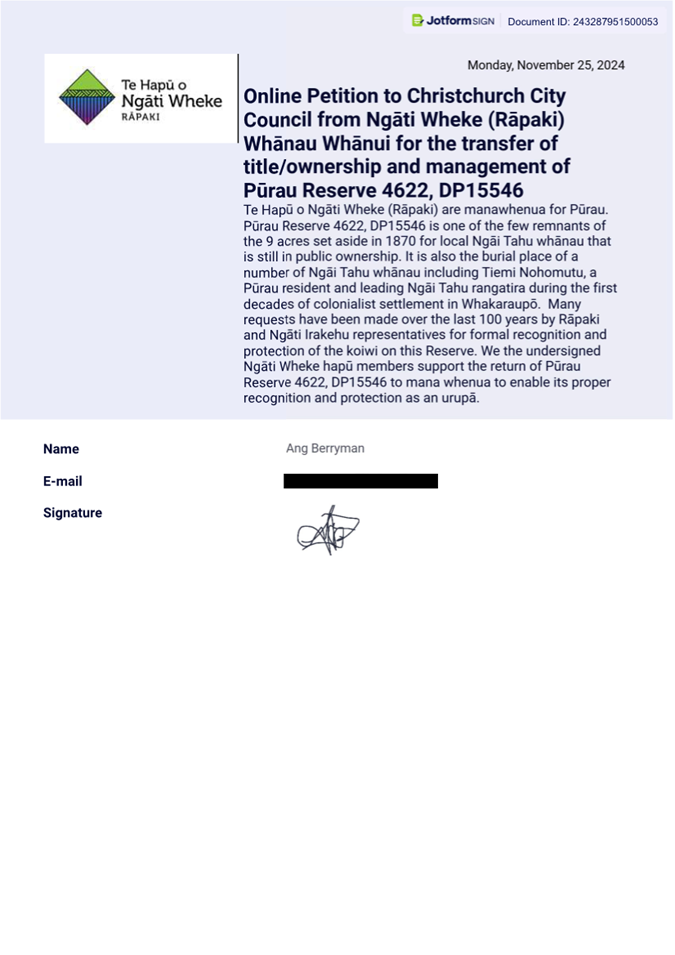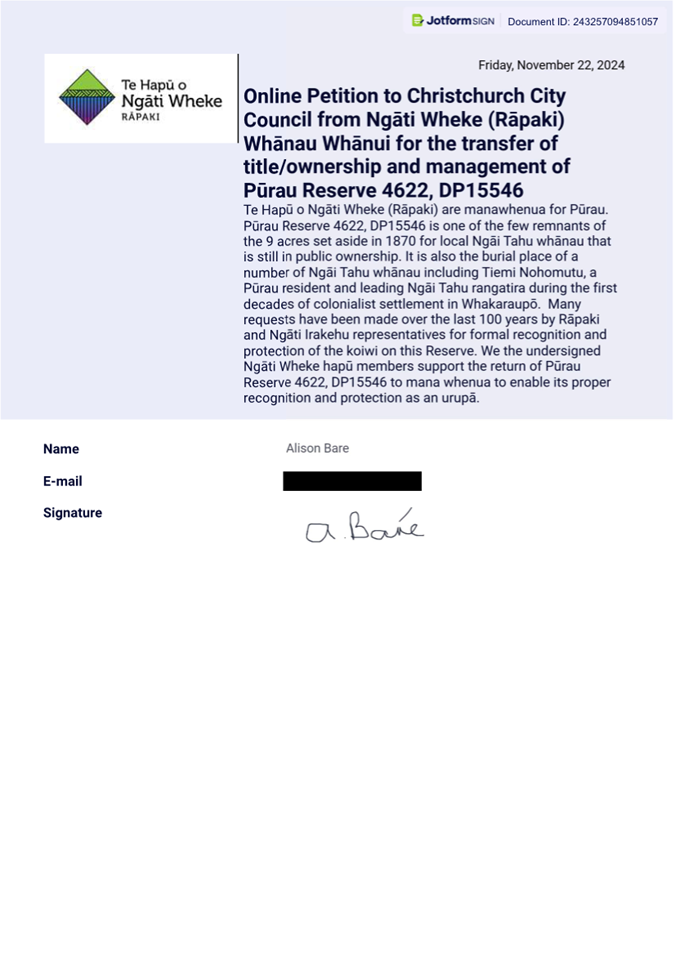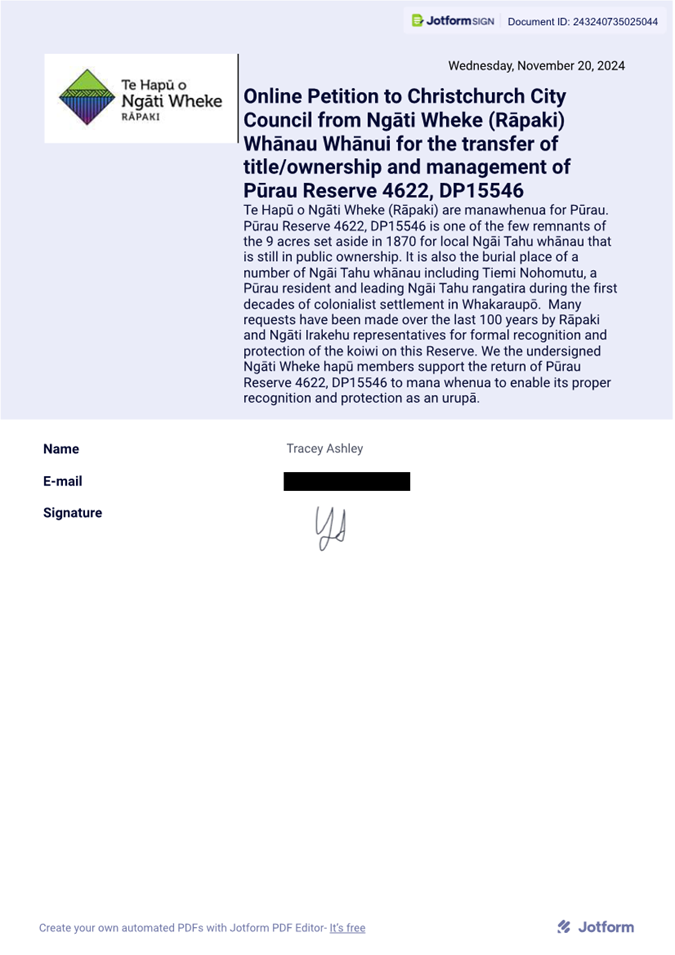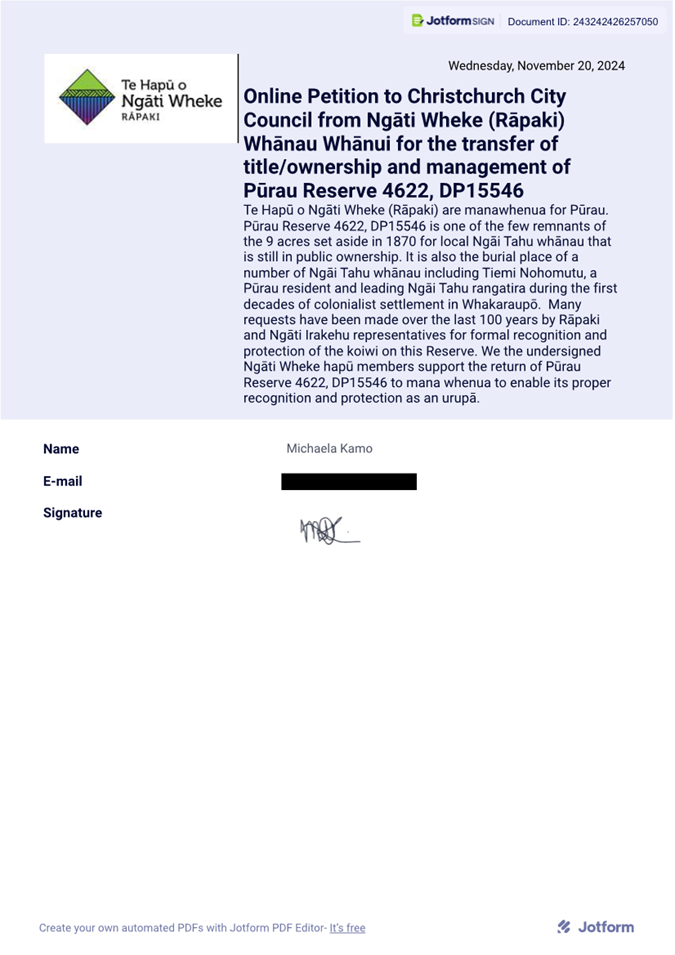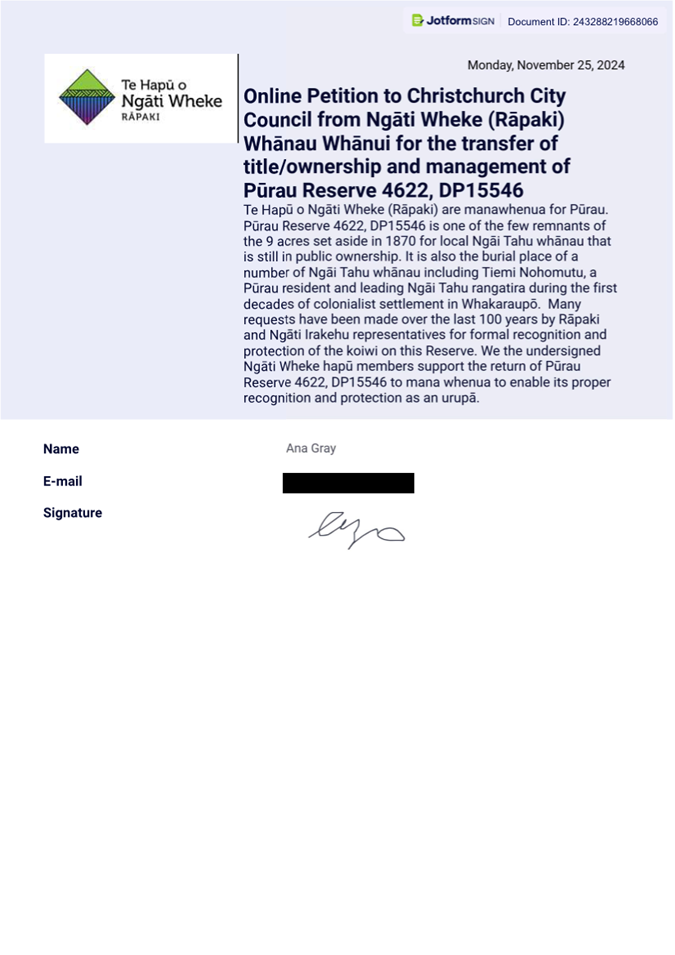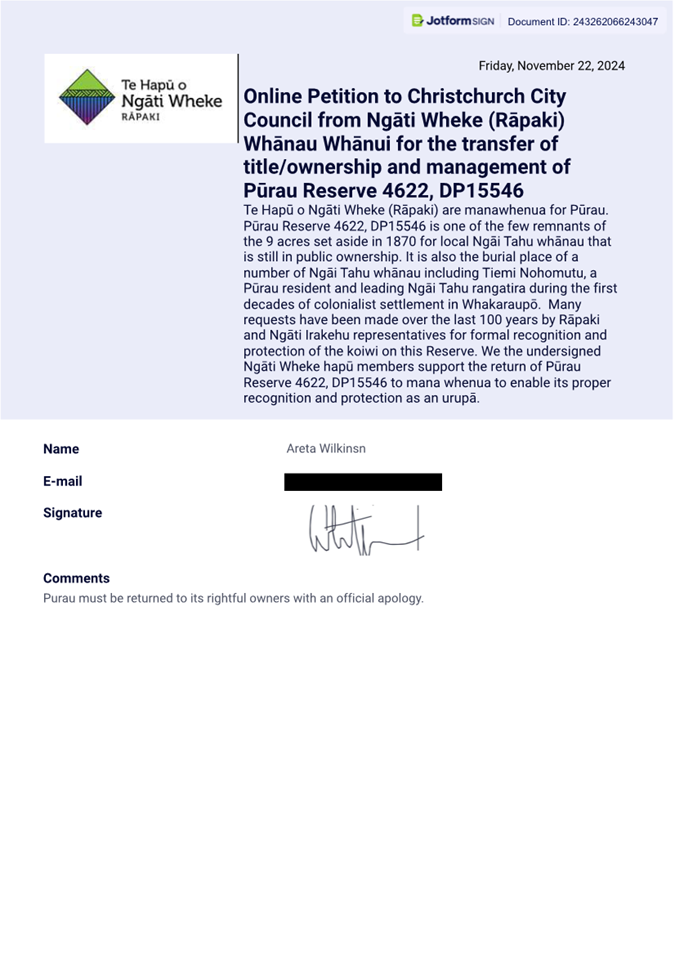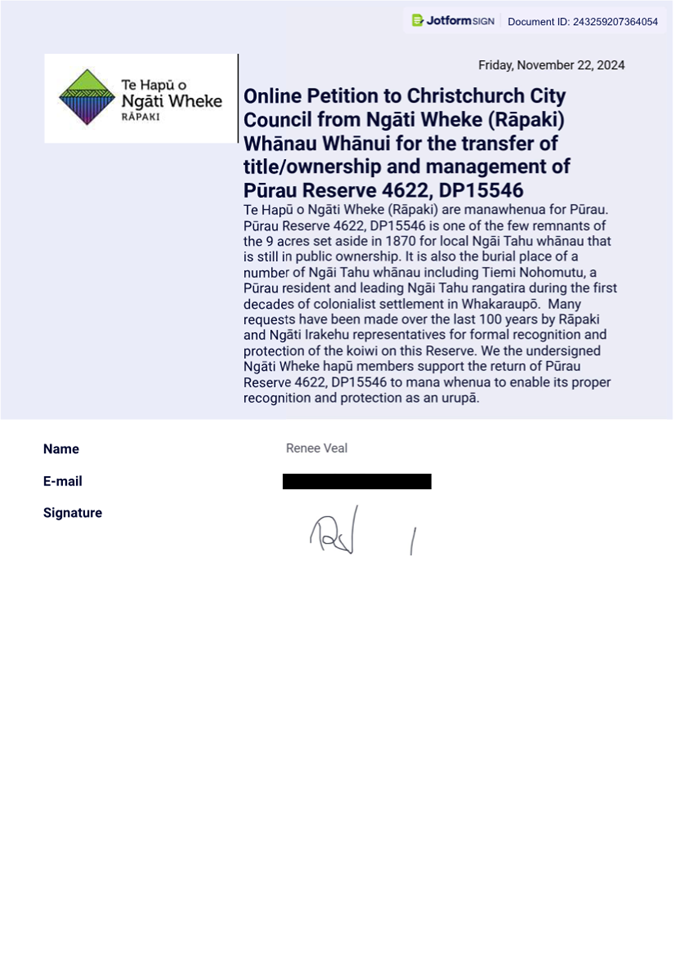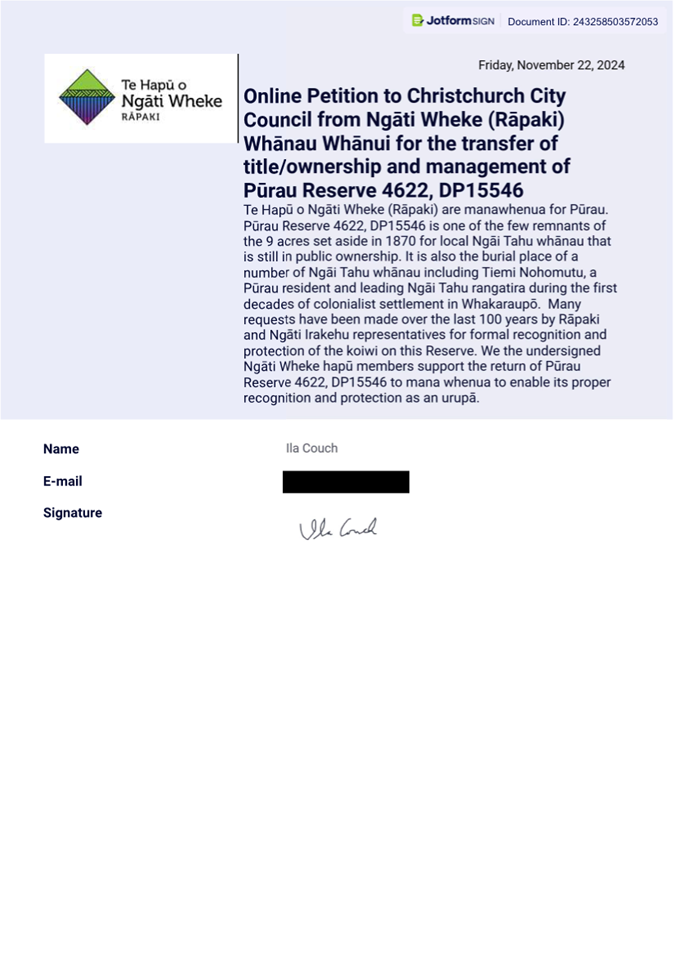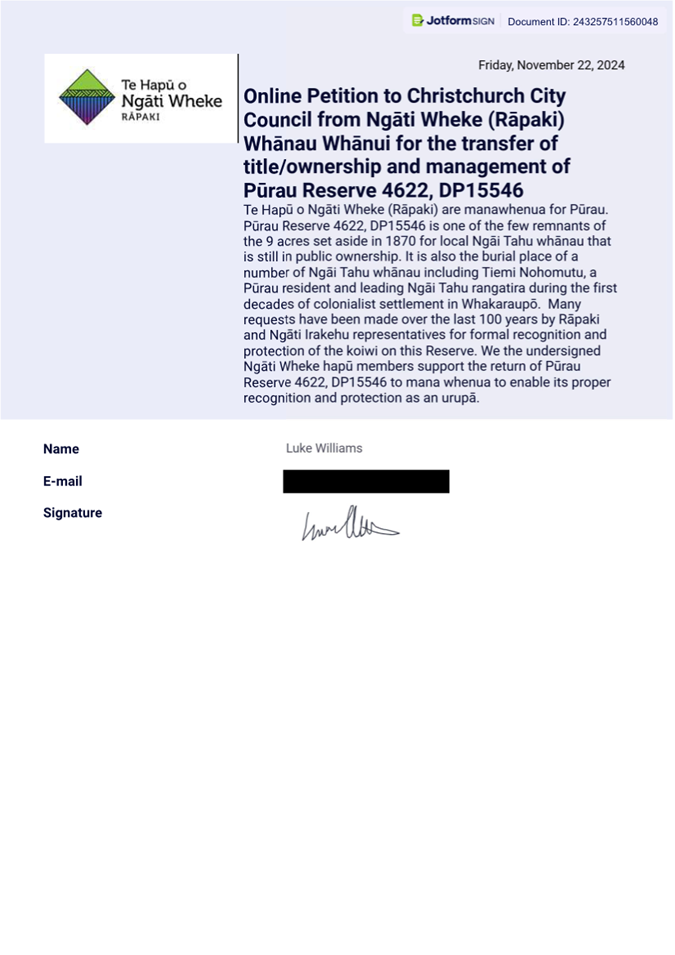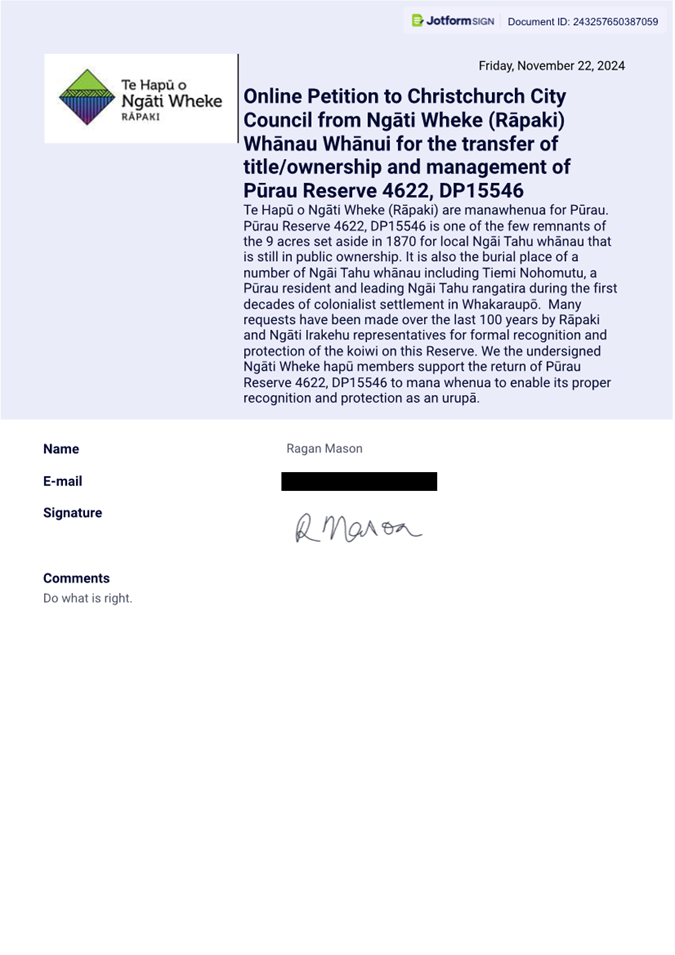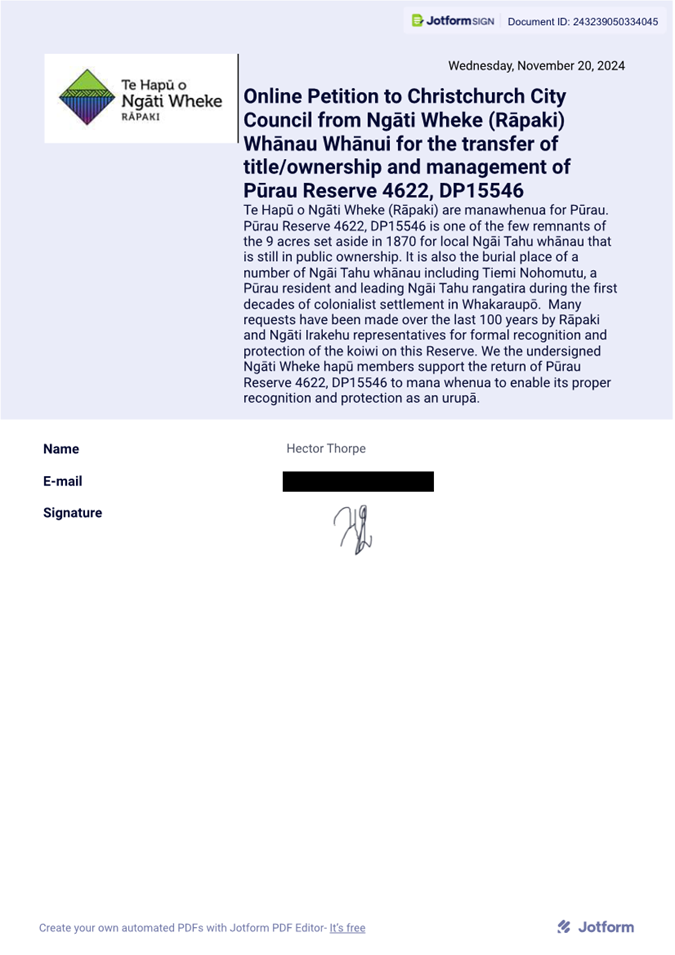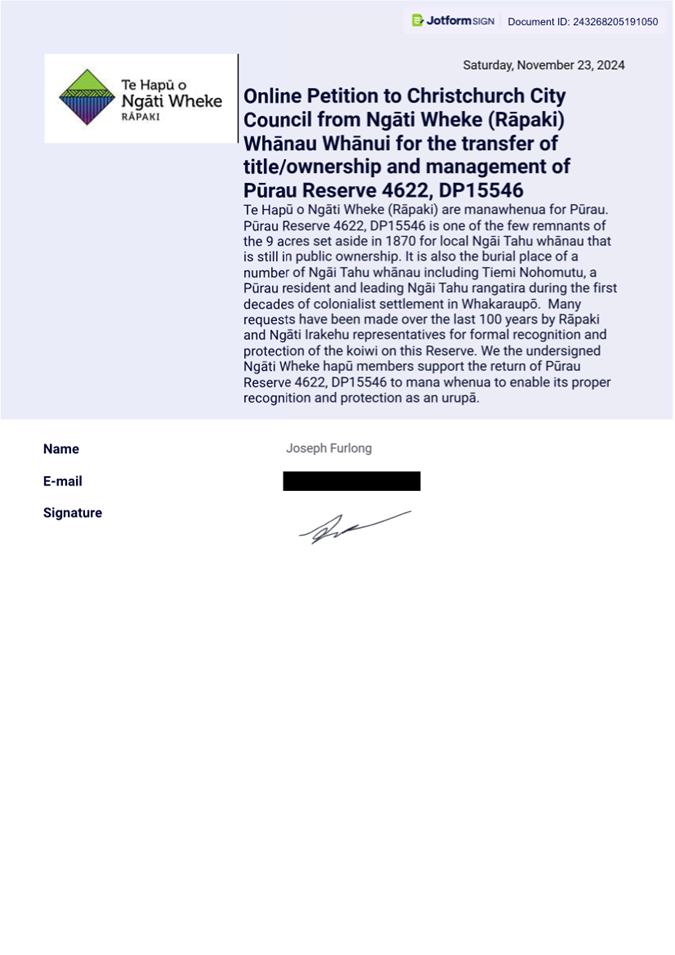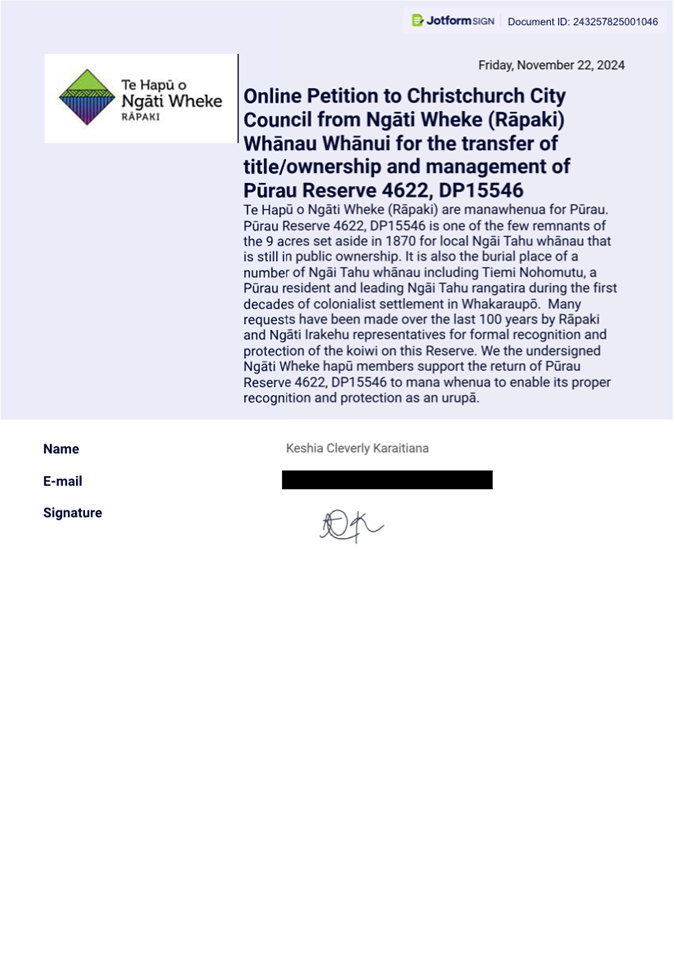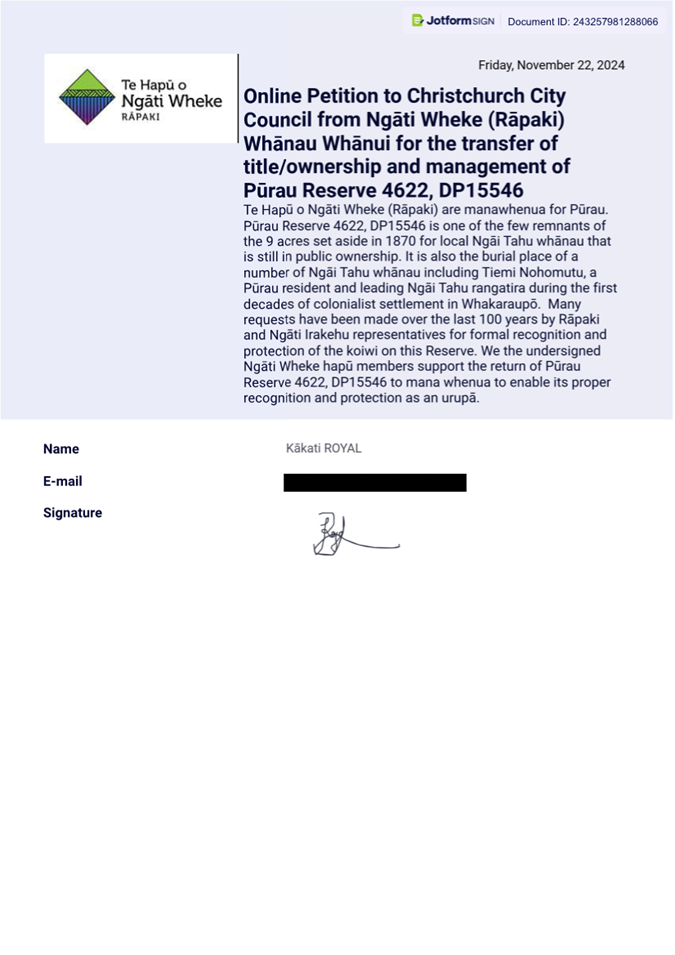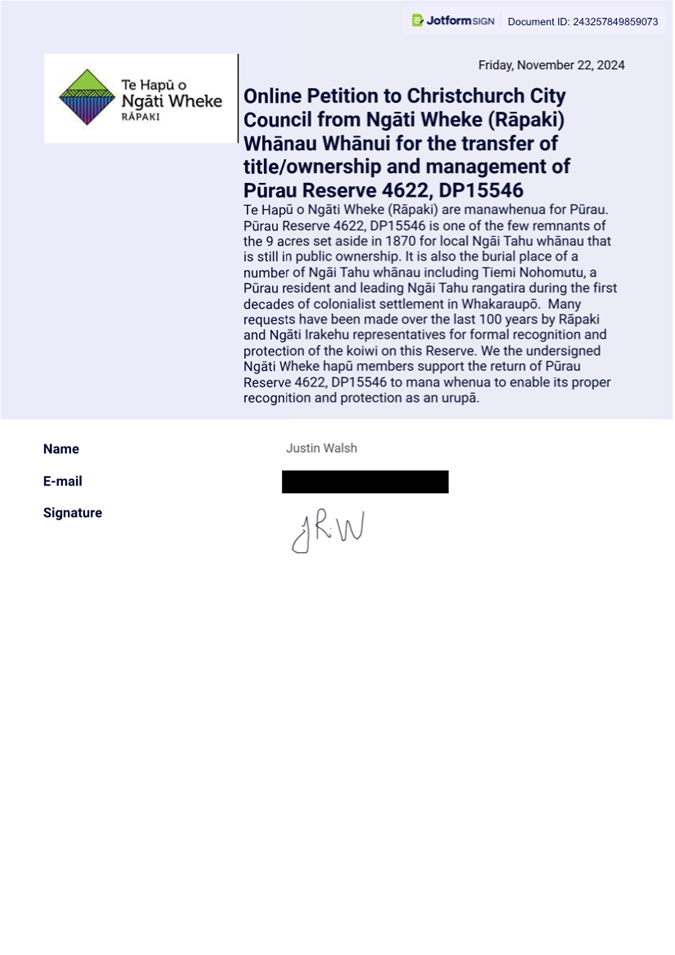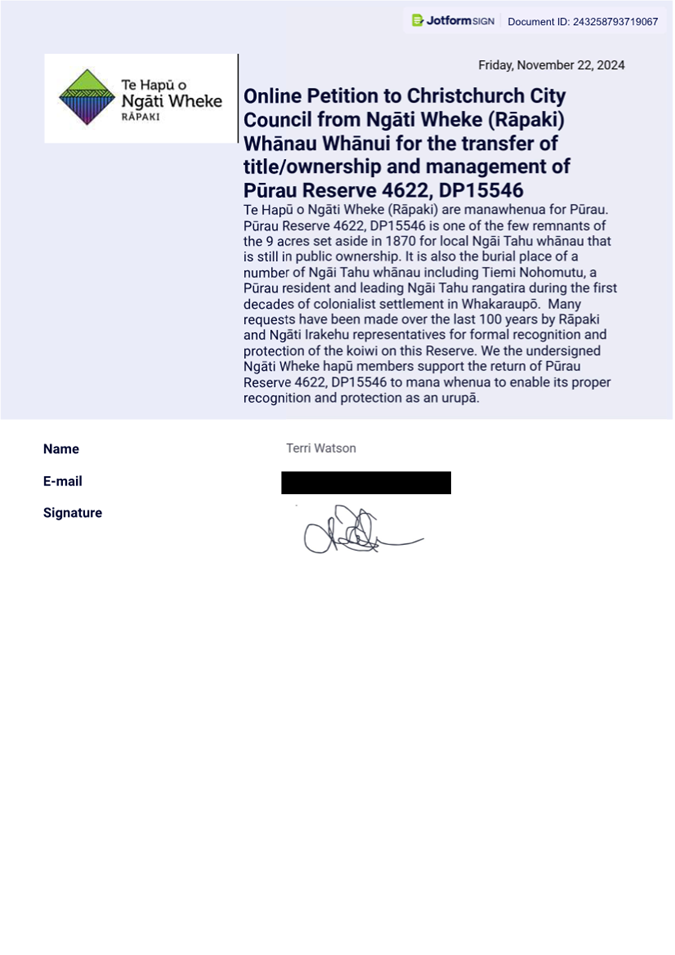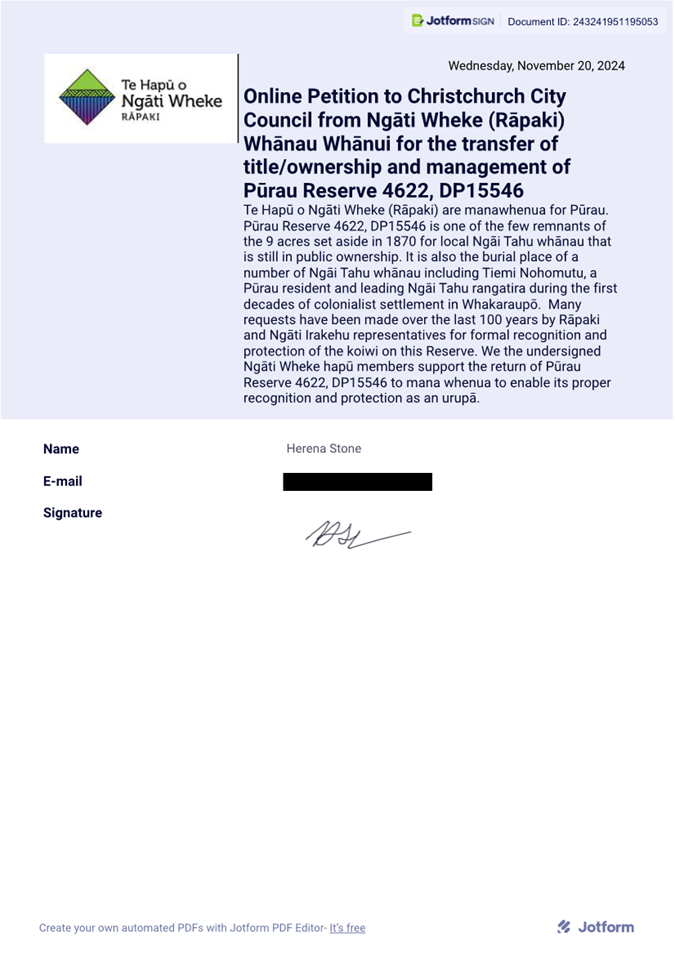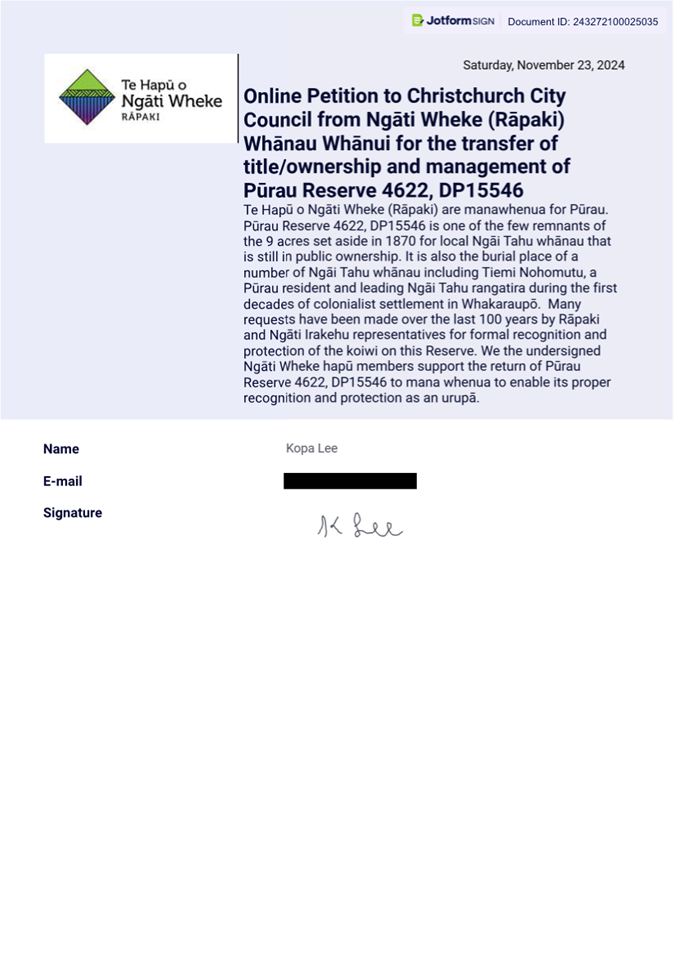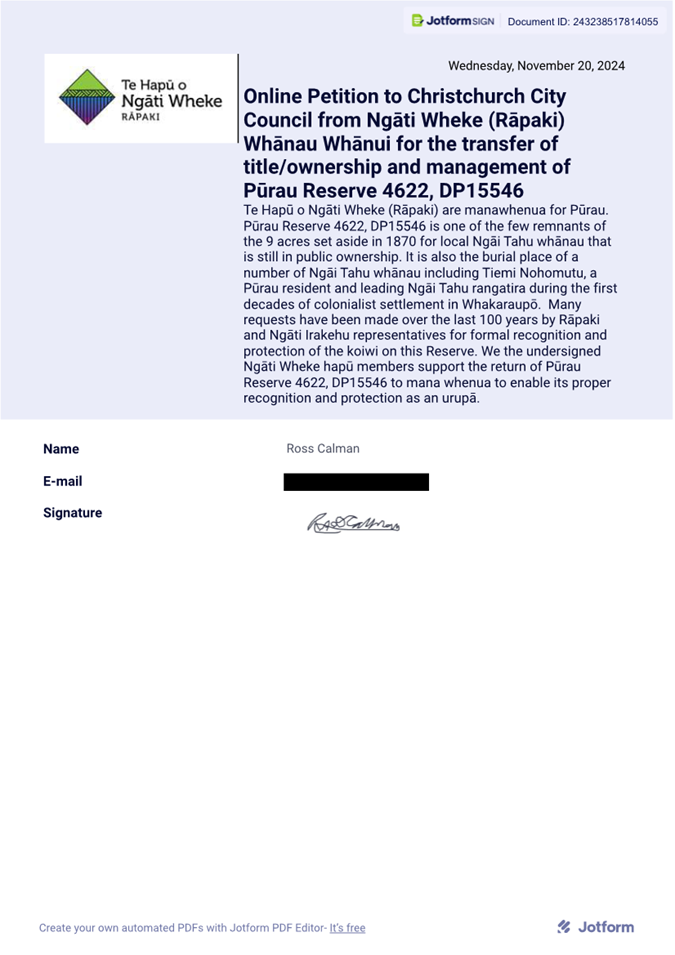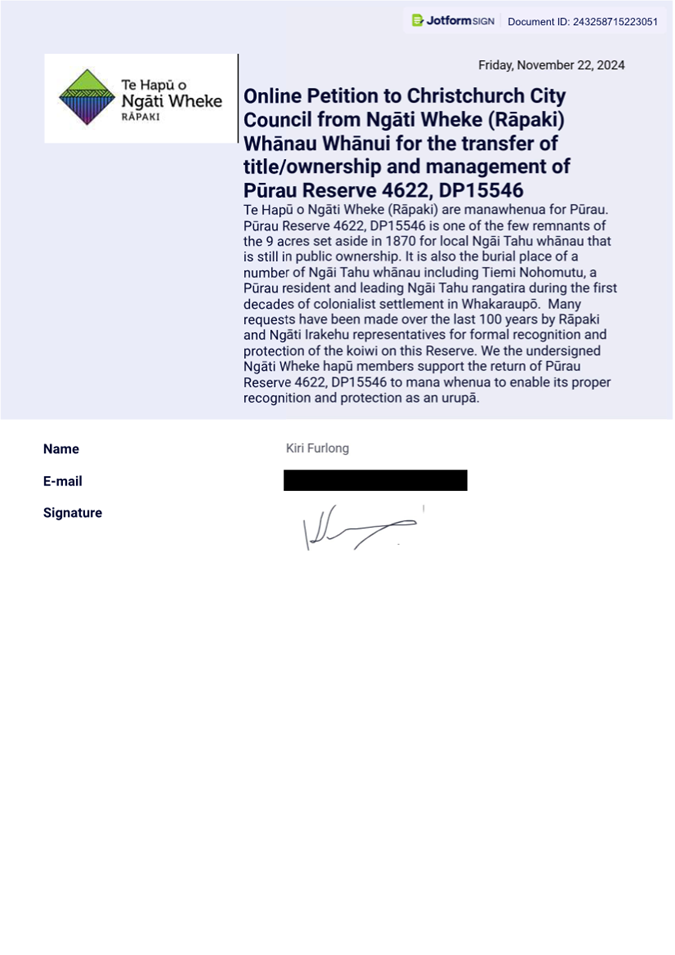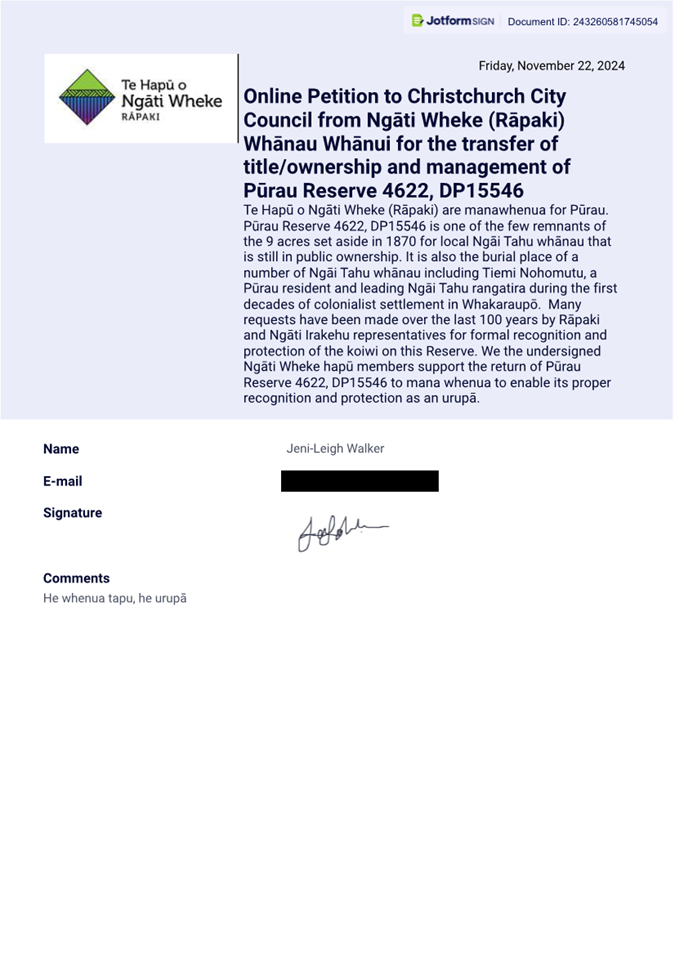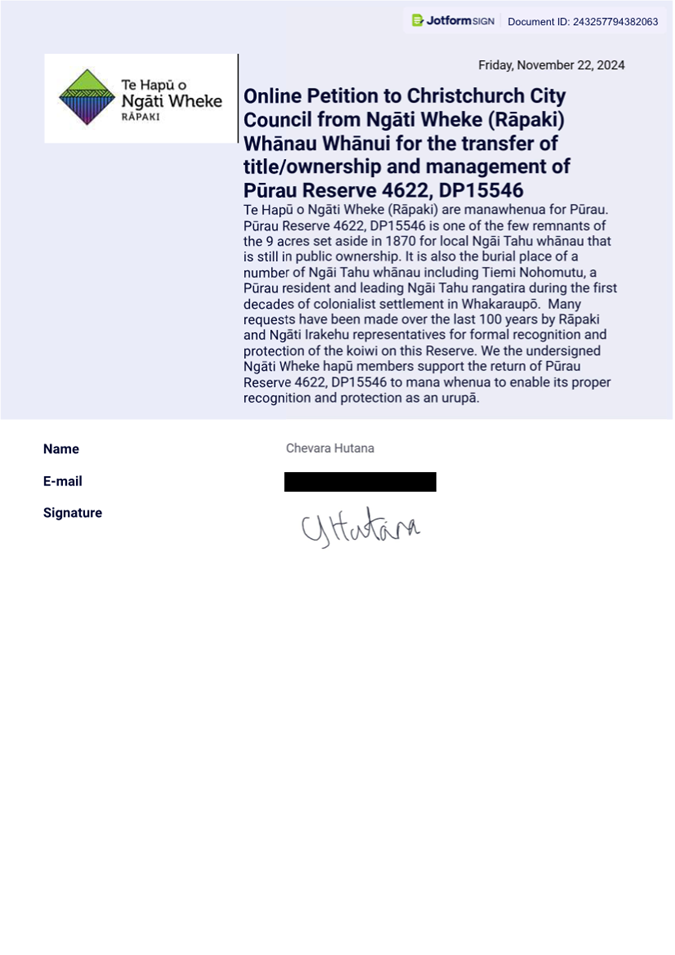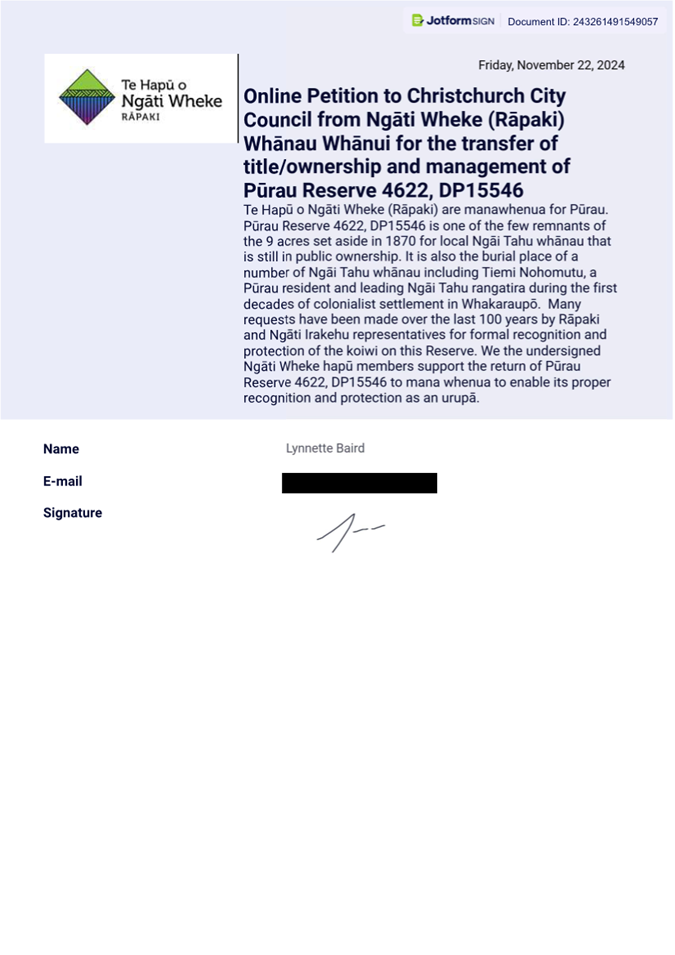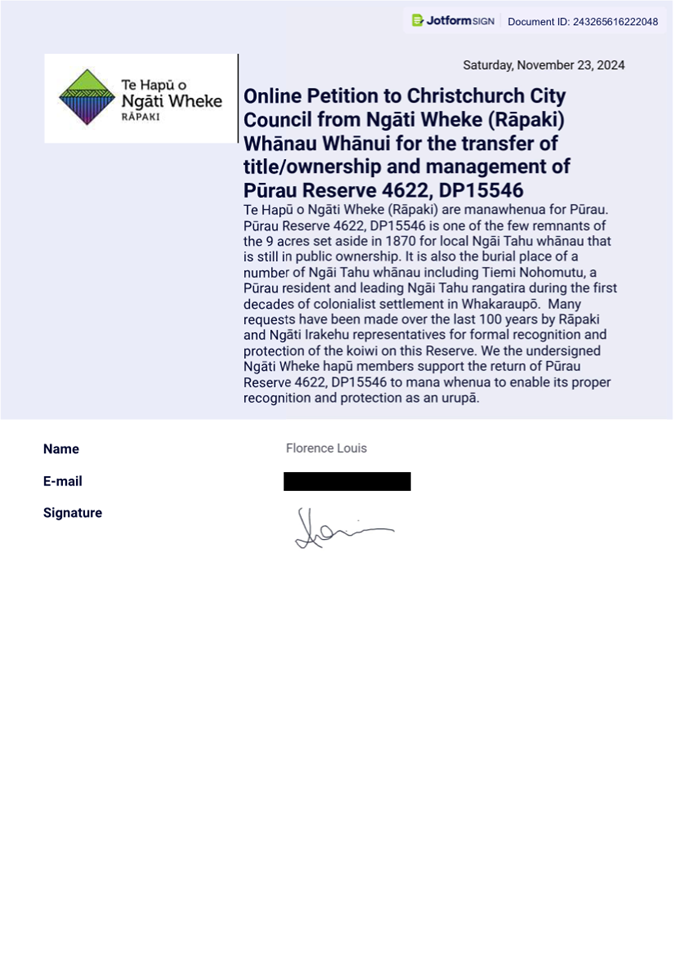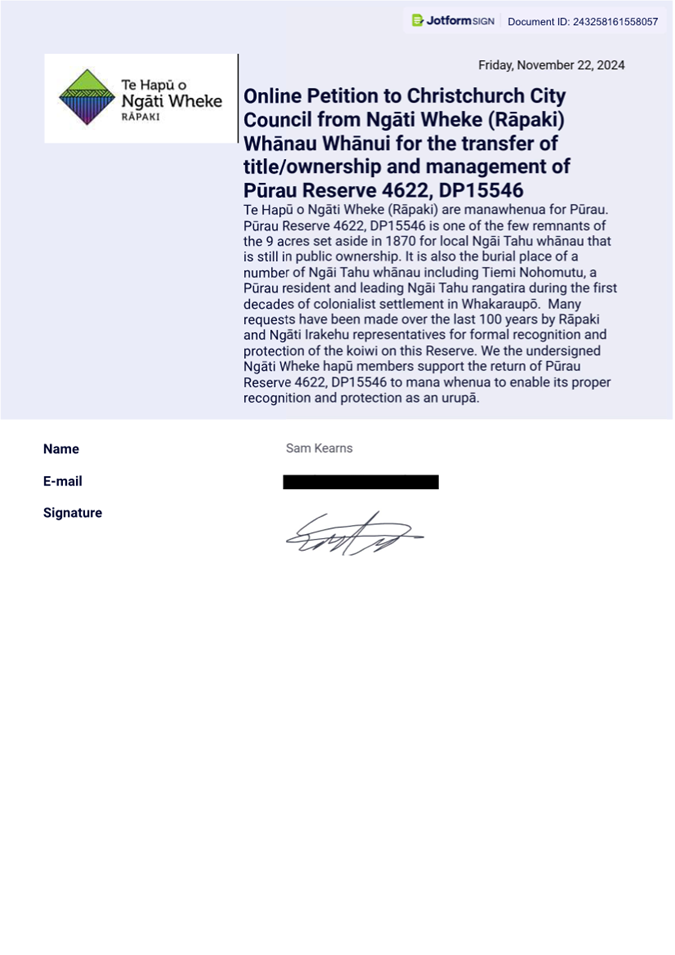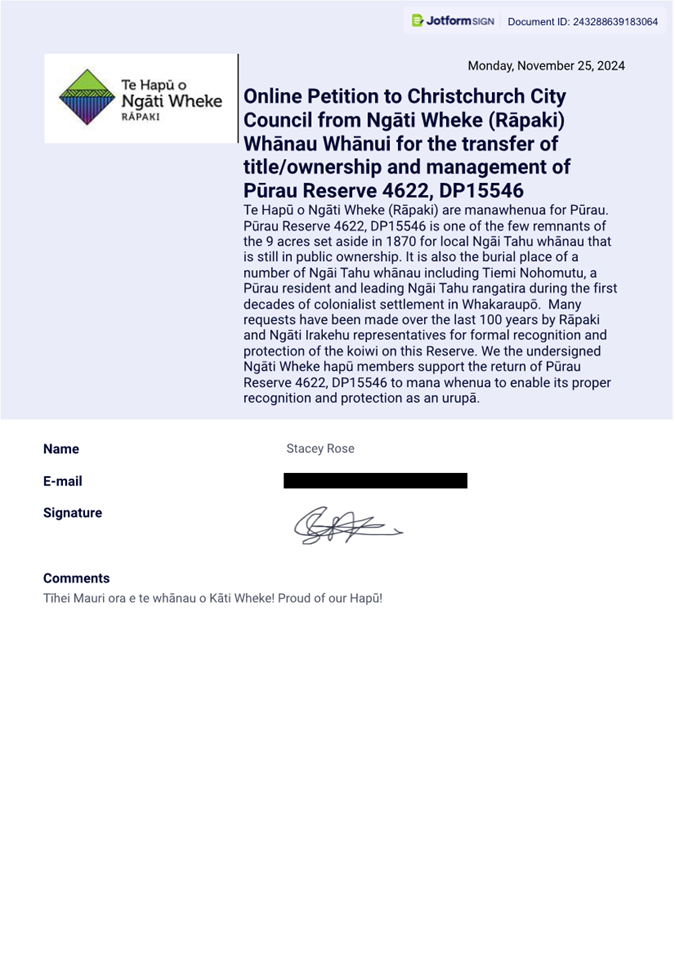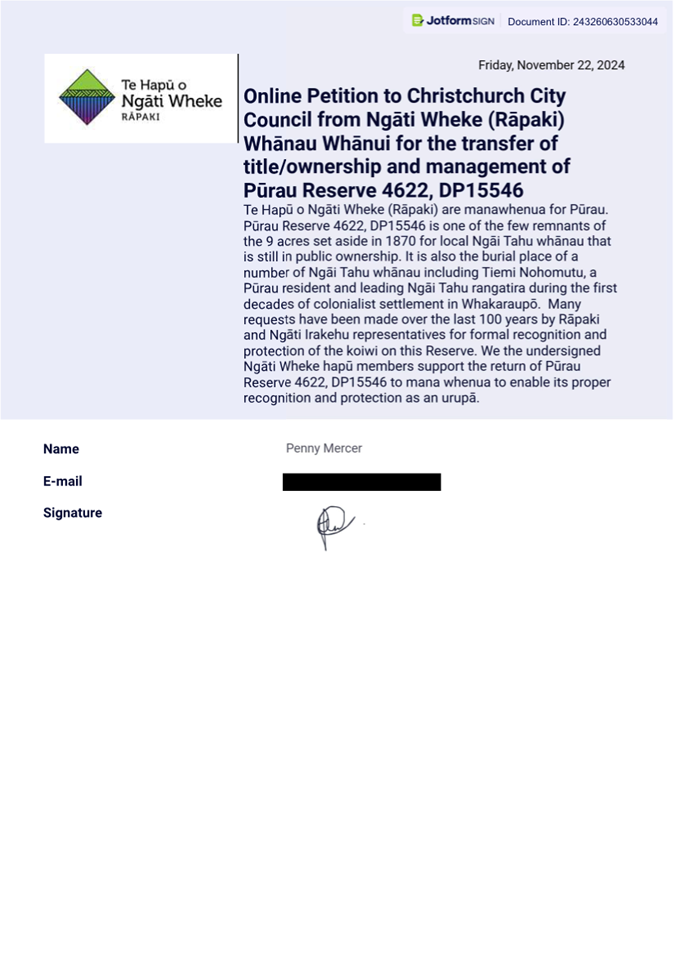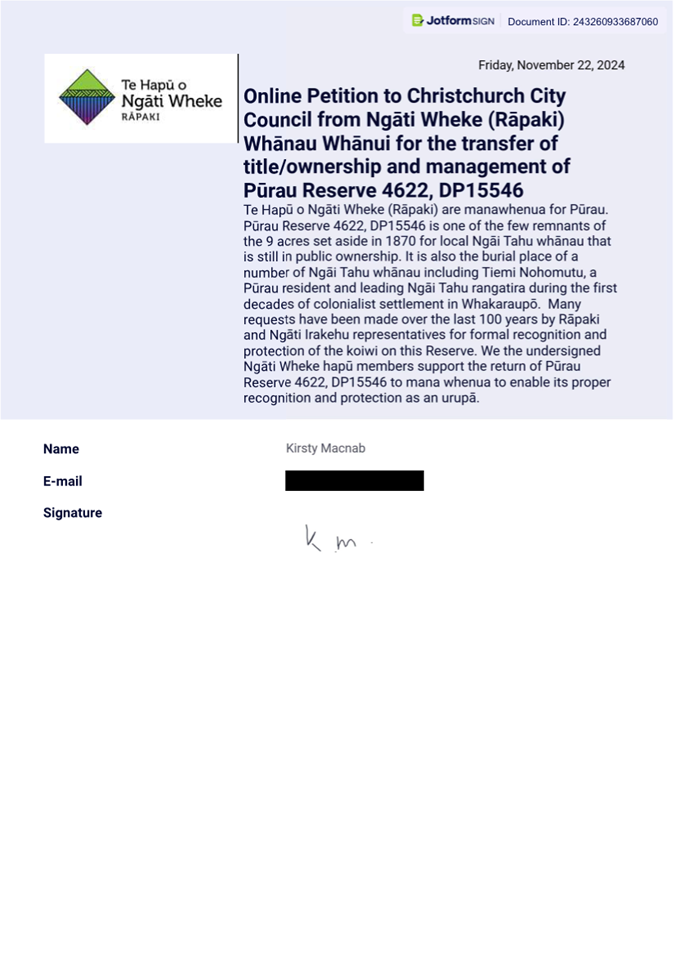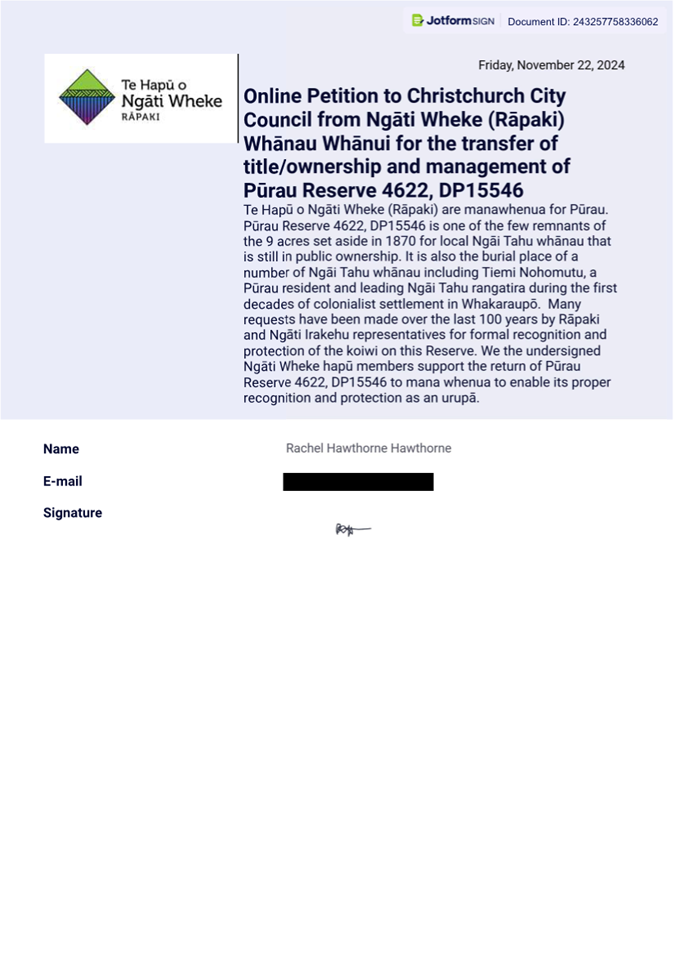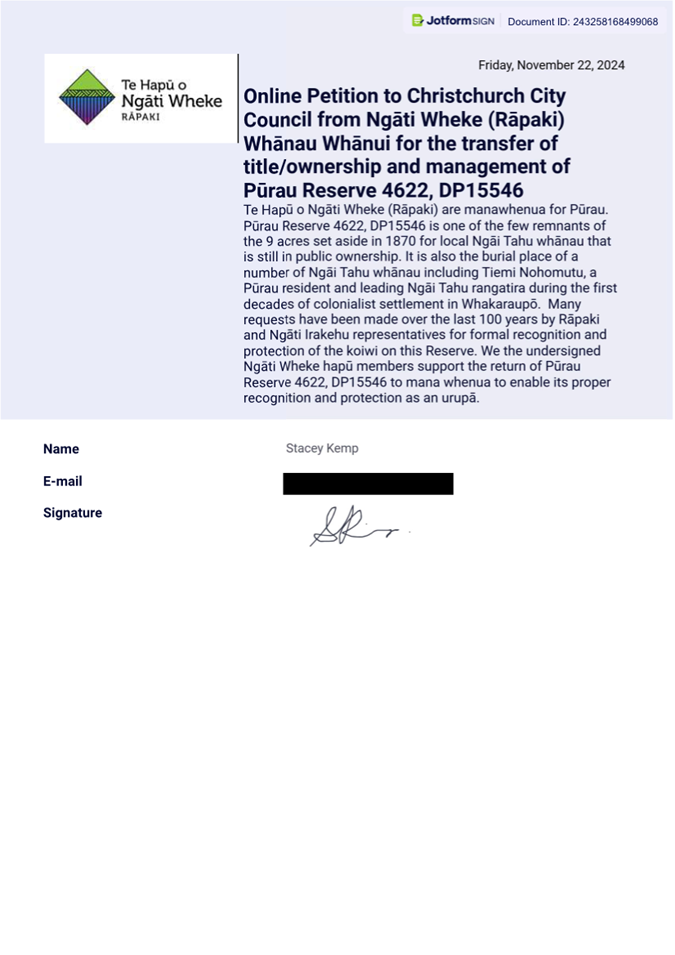|
4. 177 Pūrau Avenue return by way
of transfer to Te Hapū o Ngāti Wheke
|
|
Reference Te Tohutoro:
|
24/2207345
|
|
Responsible Officer(s) Te Pou Matua:
|
Angus
Smith, Property Consultancy Manager
Claire Fletcher, Senior Engagement Advisor
|
|
Accountable ELT Member Pouwhakarae:
|
Lynn
McClelland, General Manager Corporate Services
|
1. Purpose and Origin of the Report Te Pūtake Pūrongo
1.1 The
purpose of this report is for Te Pātaka o Rākaihautū Banks
Peninsula Community Board to receive the written and oral submissions, officer
recommendations, and under delegated authority from the Council, decide on the
proposal to revoke the reserve status of the property at 177 Pūrau Avenue
and to return it to Te Hapū o Ngāti Wheke.
1.2 The report is staff initiated.
2. Officer Recommendations Ngā Tūtohu
That Te Pātaka
o Rākaihautū Banks Peninsula Community Board:
1. Receives the information in the 177 Pūrau Avenue return by way
of transfer to Te Hapū o Ngāti Wheke report
2. Notes that the decision in this report is assessed as medium
significance based on the Christchurch City Council’s Significance and
Engagement Policy.
3. Notes that while defining and attributing a specific area to the
urupā is not precisely possible there is sufficient evidence to support
that 177 Pūrau Avenue comprising 1381 m2 held in record of title 841068
and legally described as Reserve 4622 (Property) has a culturally
significant history and there is recognition of urupā on a significant
portion of, and around, the Property
4. That fair and reasonable consideration has been given to all
submissions/objections and all information in accordance with section 78 of the
Local Government Act 2002 and section 24 of the Reserves Act 1977.
5. Revoke, pursuant to section 24 of the Reserves Act 1977, the reserve
status of 177 Purau Avenue (Property) . The reasons for this decision being
that the reserve purpose and status is inconsistent with the cultural history
and significance of the property and/or the protection and recognition of
urupā on or around the site.
6. Authorise that the reserve revocation process for 177 Purau Avenue
is commenced in accordance with the Reserves Act 1977.
7. Following the revocation process, agree that the Property
Consultancy Manager deals exclusively with Te
Hapū o Ngāti Wheke in relation to the
transfer of the property at 177 Pūrau Avenue, comprising 1381 m2 held in
record of title 841068 and legally described as Reserve 4622, for the
consideration of $1 on the basis that there is a clear
reason to do so under the Disposal of Council Property Policy 2000,
specifically that the exclusive dealing:
a. Establish appropriate ownership control and
use of the land that supports the cultural history and significance of the site
and/or the protection and recognition of urupā on or around the site.
b. Recognise that Urupā have been identified on or around the
site, and the cultural history and significance of the site and surrounding
area means that disposal to any other party or making it available for other
Council purposes would be culturally insensitive and would not meet the
Council’s obligations under Te Tiriti o Waitangi as it applies to the
administration of reserve land.
c. Establish that Te Hapū o Ngāti Wheke is the only logical and rightful owner of the land as mana
whenua and kaitiaki of the urupā.
d. Achieve the Council’s Strategic Framework objectives.
8. Authorise the Property Consultancy Manager to implement all the
above resolutions and in doing so make any reasonable decisions necessary at
his sole discretion in general accordance with this report, its intent and
resolutions.
3. Executive Summary Te Whakarāpopoto Matua
3.1 The
Community Board (12 August 2024) and Council (4 September 2024) considered a
report in respect of a Council owned block of land (Attachment A) at 177
Pūrau Avenue, referred to as Pūrau Māori Reserve, that has been
the subject of conversation with Te Hapū o Ngāti Wheke over a number
of years, focused on establishing appropriate ownership, control and use. This
property is a significant burial site (urupā). The
current status of this land and how Council holds it under the Reserves Act
1977 does not recognise or protect the urupā on or around the site, nor
the historic and cultural significance of the site and surrounding area to Te
Hapū o Ngāti Wheke.
3.2 The
Board recommended to the Council and the Council resolved to: “Consult (to be no less than eight weeks) with the community in
relation to the proposal by Te Hapū o Ngāti Wheke to transfer the
property at 177 Pūrau Avenue comprising 1381 m2 held in record of title
841068 and legally described as Reserve 4622 for the consideration of $1 to Te
Hapū o Ngāti Wheke.” (CNCL/2024/00125).
3.3 The
recommendation and resolution also provided: “If any objections, or other considerations that might require a
change in the process, are received through consultation, delegate to Te Pātaka o Rākaihautū Banks
Peninsula Community Board, the authority to hear and determine the submissions
and objections.”
3.4 That
consultation has occurred, and this report sets out in full the submissions
received and the material facts to be considered by the Community Board, under
its delegated authority from the Council, to determine this matter.
3.5 The
resolution above recommended by staff follows an analysis of the facts, the
submissions received in support and opposition.
4. Background/Context Te Horopaki
4.1 The
Community Board (12 August 2024) and Council (4 September 2024) received a
report that sought to consider a proposal by Ngāti Wheke to return the
Council-owned property known as Pūrau Māori Reserve, 177 Pūrau
Avenue (Property) to Te Hapū o Ngāti Wheke, and if that proposal
was supported to seek approval to commence the process to further consider the
proposal.
4.2 That
report resulted in the Council resolution (CNCL/2024/00125) set out in full Attachment
B. In summary it was resolved to consult with the community in relation to
the proposal. There have been submissions in opposition to the proposal
therefore in accordance with the resolution this matter is reported to Te
Pātaka o Rākaihautū Banks Peninsula Community Board, who have
the delegated authority from the Council to hear and determine the submissions
and objections.
4.3 The
summary and detail of the submissions is set out in sections 6.25 – 6.36
below and Attachment C.
Background
Recap
4.4 The
Council owned block of land at 177 Pūrau Avenue referred to as Pūrau
Māori Reserve has been the subject of conversation with Te Hapū o
Ngāti Wheke over a number of years. The Property is a significant urupā (burial site). While it is referred to as a Māori Reserve, it
is not officially classified as such. It is referred to as a “public
purpose” reserve but has no official purpose under the Reserves Act 1977.
The current status of this land does not recognise or protect the urupā on
or around the site, nor the historic and cultural significance of the site and
surrounding area to Te Hapū o Ngāti Wheke.
4.5 The
conversations with Te Hapū o Ngāti Wheke have been focused on
establishing appropriate ownership, control and use of the Property that
supports the cultural history, values and significance of the Property, to
protect and recognise that there is an urupā on or around the site. These
outcomes are not currently achieved through Council ownership held under the
Reserves Act 1977.
4.6 Setting
aside previous considerations and attempts to establish appropriate use
of the Property as a culturally significant site, a recent
indication from the Department of Conservation to support an application to
revoke the reserve status paved the way to consider a process that could see
the Property more appropriately owned, controlled and managed by Ngāti
Wheke.
4.7 This
resulted in a report and the above-mentioned Council resolution CNCL/2024/00125
recommending commencement of a process, which involved:
4.7.1 Community
consultation and engagement to consider,
4.7.2 Revocation of the
reserve status under the Reserves Act 1977.
4.7.3 Agreement to terms
and conditions for an exclusive dealing with Ngāti Wheke over the transfer
of the Property.
4.8 We
are therefore now at the point of considering the consultation and engagement
results to determine this matter.
Material
Facts
4.9 In
considering this matter the Community Board will consider the following:
4.9.1 Whether there is an urupā on or around the Property, and if so, whether and how that should
be recognised.
4.9.2 What the appropriate protection, ownership control and use of the Property
that supports the cultural history and significance is.
4.9.3 The community views
and preferences obtained through the consultation process here within reported
and the material facts.
4.10 There
is a lot of history and archival information associated with the Property and
its ownership and use. This was set out in the prior report and consultation
documentation. Some of this has been captured in the submissions, interpreted
and presented as conjecture to the exact location of the urupā. The reality is that the
exact location of the urupā cannot be accurately
identified. There are however some pertinent facts that provide a reasonable
body of evidence to support the conclusion that an urupā is on, and around, the Property.
Salient archival
records
4.10.1 All the archival information
supports the fact there is an urupā in and around
this area.
4.10.2 Since 1915 there has been
dissatisfaction with the fact the urupā in and
around this area has not been recognised or appropriately owned and managed.
This has resulted in decades of conversations to remedy that fact.
4.10.3 It is indisputable that the
Property contains the grave of Tiemi Nohomutu.
The only attempt
to map the location of the urupā occurred in 1915
when the Commissioner of Crown Lands asked the County Clerk of the then Mount
Herbert County Council to indicate on a survey plan the position of the urupā. The resulting plan is attached with the County Clerks marked on
location circled.
4.10.4 The following plans show that
marked area overlayed, by a surveyor, to scale with the current title
boundaries. Clearly indicating a reasonable overlap with the Property.


4.10.5 The Property was part of a
larger block of land (9 acres) established in 1870 as Māori Reserve 876.
The land was sold into private ownership in 1914. The private landowner
subdivided the land in 1950. This subdivision created the Property (177 Purau
Ave Reserve 4622). Below is that subdivision plan indicating where the surveyor
considered the approximate location of the urupā to be.


4.10.6 Various records around the time
and after subdivision indicate that the Property (177 Purau Ave Reserve 4622)
is an urupā site.
4.10.7 7 December 1950 the Deputy Chief
Surveyor submits the proposed subdivision for Ministers approval. That letter
of submission contains the following relevant to the burial ground and proposed
“Public Reserve”:

4.10.8 10 November 1959 Canterbury
Māori Tribal Executive to Mount Herbert County Council extract from
letter:

4.10.9 13 13 December 1961 There was a
meeting with District officer, Māori Affairs Department, Chief Draughtsman
(National Historic Places Trust) and the Māori Tribal Council. While
primarily focused on appropriate ownership use management and control, the
following is an extract of relevance to the site as a burial ground:

Archaeological
Investigations
4.10.10 T The following is a
summary from the prior report.
4.10.11 Archaeological Geomagnetic
Report for Pūrau, this was undertaken by Archaeology Solutions Limited
September 2009 (Bader). The critical finding of that report records that area
“as an archaeological site containing most likely occupation remains
and urupā.”
4.10.12 GPR Solutions Ltd (Shaw).
Provides some Ground Penetrating Radar results and data identifying subsurface
features and anomalies. It identifies isolated anomalies and concludes those
are assumed to be rocks or sections of tree roots, assumed utility / service
pipes and assumed possibly dried up stream.
4.10.13 An independent review of both
those findings by Frank van der Heijden Senior Archaeologist Heritage
New Zealand Pouhere Taonga concludes as follows:
Both reports
identify a number of individual anomalies within the Purau Reserve (RES 4622).
Bader concludes these possible or likely burial pits based on similar examples
elsewhere, an 1860s survey plan, and the traditional knowledge held by tangata
whenua about the past use of the subject land as part of an urupā. Shaw
assumes these are rocks or sections of tree roots but provides no further
justification for this conclusion. It is not supported by evidence obtained
during surveys undertaken elsewhere where similar anomalies have been confirmed
as such. It also has not considered any other information on the history of the
subject land parcel. Finally, it is not clear what, if any, archaeological
expertise has been utilised to come to this conclusion, even though the scope
of the investigation purports to be to ‘Interprete [sic] if there are any
signifficant [sic] subsurface features such as fire pits, graves or previouus
[sic] agricultural activity’[1], in other words, whether there is any evidence for subsurface
archaeological features.
Therefore,
in my opinion, based on Bader’s extensive expertise as an archaeologist
undertaking such surveys and the whole set of data presented, combined with the
traditional knowledge of the subject property and similar examples elsewhere,
it is reasonable to assume the individual anomalies identified are burial
sites. No evidence has been presented that makes it at this stage reasonable to
assume these are rocks or sections of tree roots. However, as indicated above,
the only way to confirm the true nature of these anomalies, is by
ground-truthing one or more of these anomalies by undertaking targeted
excavations carried out by sufficiently experienced archaeologists.
4.10.14 Underground Overground
Archaeology more recently reviewed the Archaeology Solutions Limited report.
That review concludes that the methodology and techniques employed in that
report was commonplace and an accepted practice. It states:
While there
are advances in software in the last decade, the physical data capture method
has changed little in this time. Thus, the method utilised is appropriate and
still relevant today. Dr Bader has identified that, on the basis of the
geomagnetic survey and historical research, that the site and area is
considered archaeological under NZ legislation, and that an urupā (burial
site) is most probably present.
Dr Bader is
an expert in this field and is best placed to interpret the results of the
geophysical survey, thus, the results and the interpretation presented in the
2009 report, are unlikely to be challenged by any archaeologist in New Zealand.
Thus, the
findings of the Bader 2009 report are still applicable and relevant today..
In
conclusion
4.11 While defining and attributing a specific area to the urupā is
not precisely possible, there is sufficient evidence to support that the
property has a culturally significant history and there is recognition
of urupā on a significant portion of, and around, the property.
Issues
Arising from Consultation
4.12 The key themes from the opposing submissions
and advice on those matters are as follows:
4.13 Certainty
over the future use and management. An agreement could be put in place
with mechanisms, terms and conditions that protects the future use and
management of the Property if that is what the Council considers necessary and
reasonable. The Christchurch City Council have a unique relationship with
Ngāi Tahu. This relationship is based on trust and an enduring
partnership. There are several key statutes that establish the framework for
tangata whenua participation. The Resource Management Act 1991, Te Rūnanga
o Ngāi Tahu Act 1996, the Ngāi Tahu Claims Settlement Act 1998, and
the Local Government Act 2002 all require the council to consult with relevant
Māori parties, as acknowledged by the Treaty of Waitangi. Article Two of
the Treaty states that the Treaty of Waitangi protects Māori rangatiratanga,
which refers to chiefly authority and self-determination rooted in tikanga, and
the protection of lands, forests, fisheries and other taonga or treasures.
4.14 Reclassification
as a historic reserve with control and management either left with the Council
or a co-governance type structure. This
option is viable and set out in the options analysis – Option 3. It
should be noted that a reclassification decision would require (another) its
own consultation process similar to the one just undertaken but for that
specific outcome.
4.15 Treaty
Settlement Process. The matter under
consideration has no relationship with the Treaty Settlement process, nor does
it create any precedence in this regard. The decision to be made is specific
and unique to the Property and circumstances. The fact that the Property was
alienated from Māori and Mana Whenua interests in 1914 was the direct
action of the individual Māori owner at the time, who sold the Property as
a private individual. There is no intention that the decision in this case is
to redress that action. Notwithstanding that returning the land to Mana Whenua
can be seen as an advantage.
4.16 Reserve
provisions in Purau. When the land was
subdivided in the 1950s the Land Subdivision in Counties Act required
developers to allocate a portion of land for public
reserves or pay cash in lieu as part of the subdivision process. It is evident
from the archival records that the developer wanted to both meet this provision
with land rather than cash in lieu and was desirous of recognising the area as
a burial site. The incongruity of that action was not recognised at the time
and has persisted through history to this day.
4.17 The outcomes and strategy of the 1950s approach under the Land
Subdivision in Counties Act are incompatible with modern practices. It was a
blunt tool that lacked consideration for the specific nuances and needs of
individual communities or areas, applying a one-size-fits-all approach to
reserve contributions. Today, under the Local Government Act 2002 and the
Resource Management Act 1991, local councils use development contributions
to fund a broader range of infrastructure beyond reserves. Councils develop
individualized strategies reflecting urban planning priorities, population
growth, and infrastructure needs, which vary across the country.
4.18 The Christchurch City Council determines and provides for physical
reserves through a combination of planning frameworks, community consultation,
and development contributions. In
the Council’s Parks and Foreshore Activity Plan there is a Level of
Service – Parks are provided (people have access to parks within
walking distance of home) – 80% of urban residential properties are
<500m from a park (any type of park except a utility park) at least 3000m2
in size. This Level of Service is met and exceeded in Purau, even without
the Property.
4.19 Council maintains a large area of land in Purau that is publicly
accessible open space well in excess of its policies and strategies. This
includes the foreshore, legal road and recreation reserve. The Pūrau
Recreation Reserve is 3610m2. The area of legal road known as
Pūrau Foreshore is 10,714m2 and the Pūrau Esplanade
Reserve 5358m2.
4.20 Coastal
hazards. Sea level rise is being dealt within
the Coastal Adaptation project with information and triggers specific to
Pūrau and the land administered by the Council. If it is considered a
decision can/should not made on the future use of this property because of
coastal hazards and sea level rise, then that must therefore apply to any use
and development of the land. The use is not dependant on the risk and vice versa
i.e. it does not only apply if the future of the Property is to be an urupā. Leaving it fallow and deferring
any development plans or decisions because of this risk would not make sense.
If it is determined this is an urupā then
protection for that would be required regardless of sea level rise.
4.21 Mixed/Dual
use. It needs to be understood that an urupā and Recreation Reserve are
incongruous uses for the land. If the first principal decision is made that the
Property is an urupā site,
then any conversations or thoughts about it being retained for recreation
purposes are inappropriate.
4.22 Recreation
purposes and requirements can only be considered if the site is determined not
to be an urupā, in which
case retaining the status quo would be the logical conclusion.
4.23 Apportioning
the land and subdividing the land into portions considered to be an urupā and not is not possible with
certainty as mentioned earlier in this report nor practical.
4.24 The Board has considered Pūrau
Māori Reserve (177 Pūrau Avenue) at the following meetings:
4.25 The following related information session/workshops have taken place
for the Community Board:
|
Date
|
Subject
|
|
12
February 2018
|
The Board received an update on
progress on the Lyttelton/Mt Herbert Community Board’s 20 August 2024
resolution.
|
|
4
March 2019
|
Board Seminar – the Board
received an update regarding the Pūrau Māori Reserve project.
|
|
6 May
2019
|
Board Seminar –the Board heard
from representatives from the Pūrau community and staff regarding the Pūrau Māori
Reserve project.
|
|
22
July 2024
|
Community Board Information Session
Purpose was to update the
Community Board on the changed position of the Department of Conservation and
allow the Community board to provide staff with any information believed to
relevant when consulting with the public. (Information Session to Te Pātaka o Rākaihautū Banks
Peninsula Community Board)
|
Options Considered Ngā
Kōwhiringa Whaiwhakaaro
4.26 The
following reasonably practicable options were considered and are assessed in
this report and based on the fact there is an urupā
on a significant portion and around the Property:
4.26.1 Option 1. Revoke the
reserve status and return by way of transfer the Property to Ngāti Wheke. Preferred
Option.
4.26.2 Option 2. Reclassify the
reserve and retain ownership in the Council. Not recommended.
4.26.3 Option 3. Reclassify the
reserve and retain ownership in the Council. Have an alternative governance or
administrative arrangement e.g. with an entity other than council or
co-governance. Not recommended.
4.26.4 Option 4. Do
nothing/status quo. Not recommended.
4.27 The
following options were considered but ruled out:
4.27.1 Revoke reserve status only:
Under this option the Council would go through the process to revoke the
reserve status, resulting in a fee simple unencumbered title. The Council would
retain ownership of a fee simple property, which would not recognise the
cultural significance of the land to rūnanga. This would not support Te
Hapū o Ngāti Wheke to regain the appropriate management of a
culturally significant site.
4.27.2 Apportioning the site for
partial revocation / classification treatment: This option would have to be
predicated on identifying and attributing defined areas of the site to specific
uses for specific treatment. That is not possible nor aligned with the
principle of this consideration which is an acknowledgement that there is sufficient
evidence to support the fact that this site is has a culturally
significant history and there is recognition of urupā on or around the
Property.
Options Descriptions Ngā
Kōwhiringa
4.28 Preferred
Option 1: Revoke the reserve status and return by way of transfer the
Property to Ngāti Wheke.
4.28.1 Option Description: The
reserve status is revoked creating an unencumbered fee simple parcel of land
capable of transfer from the council to Ngāti Wheke.
4.28.2 Option Advantages
· Aligns and returns ownership, management and control to the historic
rights and use of the Property.
· Addresses the cultural insensitivities and inappropriate use of the
Property.
· Aligns with Council’s responsibility to administer the
Reserves Act to give effect to the principles of Te Tiriti o Waitangi in
alignment with section 4 of the Conservation Act 1987.
· There remains adequate and appropriate public space in the area
without council retaining the Property.
· Reduced maintenance cost and liability to the Council.
· Avoids unbudgeted and planned development costs to recognise the
Property as an urupā.
· As owner, Te Hapū o Ngāti Wheke will be able to apply to
have the land set aside as a Māori Reservation under Te Ture Whenua Act
1993. This would appropriately recognise the cultural and historical
significance of the site and empower Te Hapū o Ngāti Wheke to
exercise kaitiaki responsibilities.
4.28.3 Option Disadvantages
· Some community members are concerned around the possibility of loss
of open space and public space/amenities.
· Some community members do not consider the site or part of it should
be recognised as an urupā.
4.29 Option
2. Reclassify the reserve and retain ownership in the Council. Not
recommended.
4.29.1 Option
Description: Reclassify as a historic reserve with
land to remain in Council ownership, management and control.
4.29.2 Option Advantages
· Reclassification of the site as a historic reserve would better
reflect the cultural and historical significance of the site compared to its
current status.
· Management of the reserve could be changed to better reflect the
historic and cultural values present.
4.29.3 Option Disadvantages
· Changing the reserve classification to historic would not properly
recognise the immense cultural significance of the site. An historic reserve
classification, while arguably more appropriate than the current reserve
status, does not provide the full level of protection possible for the site
that is considered necessary to protect its cultural and historical values.
Those requirements are difficult to reconcile with the values of public access
and enjoyment which underpin all reserve classifications under the Reserves Act
1977. Controls could be put in
place with that provides further protection should the Council considers
necessary and reasonable.
· Does not create alignment with the Council’s responsibility under
the Reserves Act 1977 to give effect to the principles of Te Tiriti o Waitangi
in alignment with section 4 of the Conservation Act.
· Mana whenua does not support this option.
· The necessary work to develop and manage the Property as an urupā
is currently unbudgeted or planned.
4.30 Option
3. Reclassify the reserve and retain ownership in the Council. Have an
alternative governance or administrative arrangement e.g. with an entity other
than council or co-governance.
4.30.1 Option Description: Reclassifying
the reserve to a more aligned use under the Reserves Act e.g. Historic Reserve
to reflect the cultural and historic significance of this site. Once the reclassification
process is completed, the Council could retain ownership or seek to vest
control and management of the reserve in Te Hapū o Ngāti Wheke as an
administering body. This could include co-governance.
4.30.2 Option
Advantages
· Reclassification of the reserve so it is no longer a public purpose
reserve would better reflect the cultural and historic significance of this
site compared to the current status.
· Management of the reserve would be changed to ensure it was
appropriate for the type of reserve.
· Enables a joint management approach to the land.
· A co-governance group can be structured in any way.
· Management of the reserve could be changed to better reflect the
historic and cultural values present.
4.30.3 Option Disadvantages
· Does not fully address issues of cultural appropriateness in terms
of current use of the site like Mana Whenua ownership would.
· Changing the reserve status to “historic” would not
properly recognise the immense cultural significance of the site.
· It would not fully support the appropriate management of the
urupā or measures to protect it for future generations like Mana Whenua
ownership would.
· May not effectively address control and management for an urupā.
· Te Hapū o Ngāti Wheke would not be the owner of the land.
· Would not allow for classification as a Māori Reserve under the
Te Ture Whenua Māori Act 1993.
· Potentially complex and administratively burdensome.
· As with Option 2, historical classification does not provide the
level of protection for the site that is considered necessary to protect its
cultural and historical values.
· As with option 2, it does not create alignment with the
Council’s responsibility under the Reserves Act to give effect to the
principles of Te Tiriti o Waitangi in alignment with section 4 of the
Conservation Act, unless Ngāti Wheke are involved.
· The Council would still fund the maintenance. The cost of the
necessary work to develop and manage the Property as an urupā is
currently unbudgeted or planned.
· Mana whenua does not support this option.
4.31 Option
4. Do nothing/status quo.
4.31.1 Option Description: Council
retain ownership held under the Reserves Act, managing and controlling the
Property as a public purpose reserve.
4.31.2 Option
Advantages
· Retaining this as public open space for public purposes would/could
be perceived by some members of the community as an advantage.
· The Council could seek to inform and direct the public on
appropriate behaviour and uses that reflect the cultural and historical
significance of the site (e.g. by putting up signage).
· This option would be appropriate should the first principal decision
determine that the site is not considered to be an urupā.
4.31.3 Option Disadvantages
· Provides a mixed and incongruous strategy and message.
· Perpetuates the cultural insensitivities and potential for
inappropriate use.
· Costs of ownership and management reside with the Council.
· This would not support the Council’s strategic objectives.
· Does not create clarity over management and the appropriate use of
the site.
· Does not enable the Council’s to meet its obligations under
the Te Tiriti o Waitangi as it applies to the administration of reserve land.
· As with options 2 & 3, this option limits the ability to manage
or control culturally insensitive and inappropriate activities that sometimes
happen within the reserve.
· Does not support our strategic objectives which are to partner with Ngāi Tahu to achieve meaningful
outcomes that benefit the whole community.
· Mana whenua does not support this option.
Analysis Criteria Ngā Paearu
Wetekina
4.32 The
Council’s strategic framework priorities and outcomes.
4.33 The
nature and status of the land.
4.34 The
history.
4.35 Appropriate
ownership, use, control and management.
4.36 Legal
and statutory considerations and processes.
4.37 Cultural
values.
5. Financial Implications Ngā Hīraunga Rauemi
Capex/Opex Ngā Utu Whakahaere
|
|
Recommended Option
|
Option 2 & 3 – Reclassify and
retain ownership or appoint a management/governing entity
|
Option 4 – Do nothing/status quo
|
|
Cost to Implement
|
Staff time to implement the decision,
revoke the reserve status and undertake legal transfer. Legal and processing
costs excluding staff time est. $2,000.
|
Staff time to implement the decision,
revoke the reserve status and undertake legal transfer. Legal and processing
costs excluding staff time est. $2,000. If a new entity est. $5,000 to
document.
|
Nil
|
|
Maintenance/Ongoing Costs
|
These are approx. $2,000 p.a. and
would represent a saving to council.
|
Nominal annual maintenance costs
approx. $2000 p.a.
Assuming some development work est.
$15,000 - $30,000
|
Nominal annual maintenance costs
approx. $2000 p.a.
|
|
Funding Source
|
Parks budget
|
Parks budget
|
Parks budget
|
|
Funding Availability
|
Parks budget
|
Parks budget
|
Parks budget
|
|
Impact on Rates
|
Nil
|
Nil
|
Nil
|
6. Considerations Ngā Whai Whakaaro
Risks and Mitigations Ngā
Mōrearea me ngā Whakamātautau
6.1 If
the determination confirms that revocation of the reserve status and transfer
is appropriate, there is risk associated with:
6.2 Department
of Conservation’s support for the revocation of reserve status. This has
been managed through early discussions and engagement in the process.
Indications from Department of Conservation staff are that they are in support
of the proposal and advice has been obtained regarding the process and
resolutions required.
6.3 Any
council decision carries a number of risks. Legal advice has been received on
this as it was on the prior report to effectively manage this risk.
6.4 There
is a risk in the decision to revoke the reserve status and transfer the
Property to Te Hapū o Ngāti Wheke that the outcomes anticipated are
not delivered. An agreement could be put in place with
mechanisms, terms and conditions that protects the future use and management of
the Property if that is what the Council considers necessary and reasonable to establish mitigations for this risk.
Legal Considerations Ngā
Hīraunga ā-Ture
6.5 Statutory
and/or delegated authority to undertake proposals in the report:
6.5.1 The Council resolved CNL/2024/00125 to
delegate authority to Te Pātaka o
Rākaihautū Banks Peninsula Community
Board, the authority to hear and determine the submissions and objections.
6.6 Other Legal Implications:
6.6.1 Reserves
Act 1977: The proposed revocation was publicly notified as prescribed in
the Act ss 24(2)(b) and 119. Submissions are set out in this report and
this process is the consideration of those to resolve whether to continue with
the revocation and provide the objections and resolution to the Commissioner
(s 24(2)(c)) or not.
6.6.2 Local Government
Act 2002: In accordance with s 78 of the Local Government Act 2002, the
consultation process and outcome reported on herein enables the Community Board
acting under delegated authority from the Council to consider the views and
preferences of affected/interested parties.
6.6.3 This report otherwise
meets the Council’s decision-making requirements under ss 78-82A of the Local
Government Act 2002, including consideration of the reasonably practicable
options and Māori contribution to the decision-making process.
6.7 This
report has been reviewed by the councils Legal Services Unit.
Strategy and Policy Considerations Te Whai
Kaupapa here
6.8 The required decisions align with the Christchurch City Council’s Strategic Framework. In particular the proposal meets the
framework objectives of:
6.8.1 The Community outcomes - which show a
clear alignment to the four aspects of wellbeing as set out in the LGA
(economic, cultural, social, environmental) and Te Tiriti partnership.
6.9 The
proposal and matter considered in this report are assessed as medium significance based on the Christchurch
City Council’s Significance and Engagement Policy. The level of
significance was determined by the local nature of the matter. The relatively
small population of potentially affected parties and geographically constrained area. The Property is of high cultural and historic
significance to Ngāti Wheke.
6.10 The proposal is consistent with Council’s Plans and Policies.
6.11 This
is a not a planned activity/project. It is however a legacy issue that has been
a topic of concern and conversation for years. The ability to now consider and
make a determination on this issue has arisen out of opportunity from those
ongoing conversations.
6.12 This report supports the Council's Long Term Plan (2024 - 2034):
6.13 Internal
Activities
6.13.1 Activity:
Strategic Asset Management
· Level
of Service: 13.12.20 The annual Asset Management Improvement Programme is
delivered - Notable increase in asset maturity is identified during the AMMA
assessment
· That is to provide property solutions on a project basis that service the
Council to achieve its strategic objectives while also safeguarding the Council
in terms of compliance in a balanced and considered way.
Community Impacts and Views Ngā Mariu
ā-Hāpori
6.14 The
considerations in this report have evolved from conversations with Ngāti
Wheke whose views were set out in the prior report. Theirs and other community
views/preferences/concerns are set out in this report.
6.15 The
decisions in this report are of medium significance in relation to the Christchurch City Council’s Significance and Engagement Policy
2019. The level of significance was determined by
the impact on Māori, Māori culture and traditions, the level of
community interest in the project both in the past and at present, the number
of residents affected in relation to the rest of Christchurch and Banks
Peninsula and the impact on those affected.
6.16 Engagement
with Pūrau residents began prior to the consultation opening, in July and
August 2024. Staff first met with a Pūrau resident (Mr Christie) after the
Community Board meeting held 22 July 2024.
6.17 Staff then worked with the Pūrau Residents’ Group Chair
to coordinate and deliver a community meeting held 28 September 2024which had
17 attendees. At that meeting staff outlined the consultation process, the
proposal to be consulted on and the process that would need to be carried out
if the proposal was approved.
6.18 On 30 September 2024 staff attended the Diamond Harbour Reserves
Management Committee meeting where 12 people attended and received the same
information as residents at the previous meeting.
6.19 Public consultation started on Thursday 3 October 2024 running for
eight weeks until Sunday 1 December 2024. An email was sent to 74 key
stakeholders, including community members who had previously participated in
public consultation about the reserve and foreshore in 2017/18, Ngāi Tahu
Papatipu Rūnanga, Pūrau Residents’ Group, Diamond Harbour
Reserves Management Committee, Banks Peninsula Conservation Trust and the
Department of Conservation.
6.20 The consultation was hosted on Kōrero
mai | Let’s Talk which had 2,668 unique views
throughout the consultation period.
6.21 The consultation flyer was hand delivered to all letterboxes in
Pūrau Bay and mailed to all absentee homeowners
6.22 A public notice ran in the Press Wednesday 23 October 2024.
6.23 A drop-in session was held on Saturday 26 October 2024 and attended
by 14 people.
6.24 Property owners adjacent to the reserve were contacted directly. Two
property owners had in-person meetings with the Project Lead over the course of
the project. The third property owner was approached via phone, email and
direct mail but did not get in touch.
Summary of Submissions Ngā Tāpaetanga
6.25 Submissions were received from eight recognised organisations, one
residents’ group and 370 individuals. All submissions are available
in Attachment C.
6.26 Lincoln University class MAST319 provided one submission online
signed by 16 students and staff.
6.27 Te
Hapū o Ngāti Wheke submitted a petition (Attachment D) in
support of the proposal signed by 82 signatories, of which 14 had also provided
a submission.
6.28 The
organisations that provided submissions included Te Rūnanga o Ngāi
Tahu, Te Hapū o Ngāti Wheke, Ōraka Aparima Rūnaka Inc,
Canterbury Regional Council, Heritage New Zealand Pouhere Taonga, Rod Donald
Banks Peninsula Trust, Hidden Valley Trust and Java Dance Theatre of which all
supported the proposal citing the cultural, historic and spiritual importance
of the site and the desire to see Te Hapū o Ngāti Wheke enabled to
uphold their kaitiakitanga responsibilities to protect and maintain the site,
and the ancestors within it, for future generations.
6.29 Overall, 96.3 % (365) supported the proposal, 2.3 % (9) did not
support the proposal and 1.1% (5) were unsure.
Pūrau permanent residents and property owners
6.30 Of the 30 submissions from people who identified as owning a
property and/or permanently living in Pūrau, 70.9% (22) supported the
proposal, 19.3% (6) did not support the proposal and 3.3% (2) were unsure,
which included the Pūrau Residents’ Group.
6.31 The
Pūrau Residents’ Group submission shared that “Purau Residents
group has conflicting opinions on the future reserve status of Reserve 4622,
therefore the residents will not be submitting a joint submission, with
individual submissions recommended” and so the group submission received
was marked “unsure” in their completed submission form.
6.32 Those
who supported the proposal made the following comments:
· They consider the reserve of high cultural and historical significance to
Te Hapū o Ngāti Wheke and think it should be recognised and respected
as such.
· They consider that as mana whenua and original owners of the land, Te
Hapū o Ngāti Wheke should be the owners moving forward so that they
are able to carry out their full kaitiaki responsibilities in protecting and
maintaining the site.
· They consider the reserve to be an ancestral urupā / burial site of
at least one rangatira and possibly more and viewed as wāhi tapu/ sacred
site, some noting they thought it was already owned and maintained by the
hapū.
6.33 Of the eight submitters not in support of the proposal or were
unsure, two are adjacent landowners, and all had a range of views, which can be
read in the attached submissions table (Attachment C). Comments made by
multiple submitters include:
· Expressing a lack of confidence that Council will carry out the proposal
as outlined in the consultation.
· Suggesting an alternative classification (‘historic') and
management model.
· Requesting more information about management of the site and/or a land
management plan.
· Concern about sea level rise and the lack of public amenity if the
reserve status was changed and did not include compensation by provision of
other public reserve(s).
All other submitters
6.34 The
remaining 343 submissions in support made the following comments:
· They
consider the reserve a place of high cultural, historical and spiritual
significance to Ngāi Tahu and Te Hapū o Ngāti Wheke and that
mana whenua were the original owners and occupiers of the land so should be
recognised as such by returning the land to them.
· They consider Te Hapū o Ngāti Wheke as Kaitiaki of the
reserve who are the right people to look after the site, protect as they see
fit and should be supported to carry out tikanga and their kaitiaki
responsibilities both now and for future generations.
· The proposal honours, respects and restores the mana of the land and
the ancestors within it.
· The proposal is just, correcting past wrongdoing and addressing the
long-standing issues with activities occurring within the reserve.
· The proposal honours Te Tiriti o Waitangi and aligns with Councils
responsibilities to uphold its obligations under Te Tiriti o Waitangi.
· The proposal helps communities enrich their understanding about the
area, the protocols for wāhi tapu sites and helps people connect to one
another, to the hapū and to the surrounding environment.
6.35 The
remaining five submitters not in support or unsure about the proposal made the
following comments:
· They prefer an alternative classification (‘historic’).
· They consider reserve land across Canterbury should remain as reserve
land, shared by and accessible to all.
· They consider it unfair, when others who have sold land historically do
not have the right to have it returned.
6.36 Overall, the submissions received shared a range of perspectives
from both Pakeha and Māori, locals and non-locals. All are included in Attachment
C and should be read for a full understanding of community perspectives in
addition to this summary.
Impact on Mana Whenua Ngā Whai Take
Mana Whenua
6.37 The
decisions involve a significant decision in relation to ancestral land and
other elements of intrinsic value, therefore this decision does specifically
impact Mana Whenua, their culture, and traditions.
6.38 The
decision involves a matter of interest to Mana Whenua
and could impact on our agreed partnership priorities with ngā Papatipu Rūnanga.
6.39 This proposal has been developed in collaboration with Te Hapū o Ngāti Wheke to rectify the inappropriate use, control and management of the
site, and to ensure compliance with the partnership priorities. The contents,
actions and decisions are supported by Te Hapū o
Ngāti Wheke.
Climate Change Impact Considerations Ngā
Whai Whakaaro mā te Āhuarangi
6.40 The decisions in this report are likely to:
6.40.1 Contribute positively to
adaptation to the impacts of climate change by empowering Ngāti Wheke as
owner of this significant site to facilitate the appropriate adaptation of the
site to climate effects. This is in accordance with Kia tūroa te Ao |
Ōtautahi Christchurch Climate Resilience Strategy principles including:
· Principle 1: Honour Te Tiriti by actively protecting Māori
interests and engaging on climate issues,
· Goal 2: Understanding and preparing for impacts by empowering Te
Hapū o Ngāti Wheke,
· Goal 4: We are guardians of our environment and taonga by empowering
Ngāti Wheke as kaitiaki of the site.
· Programme 1: Building foundations – Partnership and Resourcing
– Implementing a ‘just transition lens’ for use across all
programmes by supporting the active management by the appropriate kaitiaki of
land and taonga most vulnerable to climate change.
6.41 Have no impact on emissions
reductions initiatives.
7. Next Steps Ngā Mahinga ā-muri
7.1 Should
the Community Board adopt the resolutions recommended in this report the next
steps will be:
7.1.1 Documenting agreement
with Te Hapū o Ngāti Wheke over the terms and
conditions of transfer including the condition precedent of the revocation.
7.1.2 Commence the reserve
revocation process.
7.1.3 Upon successful
revocation transfer the property.
Attachments Ngā Tāpirihanga
|
No.
|
Title
|
Reference
|
Page
|
|
a ⇩
|
Plan
|
18/326860
|
28
|
|
b ⇩
|
Minutes
CNCL/2024/00125
|
24/2247409
|
29
|
|
c ⇩
|
Submissions
table and submissions attachments
|
24/2323560
|
31
|
|
d ⇩
|
Te Hapū o
Ngāti Wheke petition
|
24/2296780
|
123
|
In addition to the attached documents, the following background
information is available:
|
Document
Name – Location / File Link
|
|
Not
applicable
|
Signatories Ngā Kaiwaitohu
|
Authors
|
Angus Smith -
Manager Property Consultancy
Claire
Fletcher - Senior Engagement Advisor
Will Wijnveld
- Senior Legal Counsel
|
|
Approved By
|
Paul Devlin -
Manager Regional Parks
Rupert Bool -
Acting Head of Parks
Andrew Rutledge
- Acting General Manager Citizens and Community
|
















































































































































